2024 Trek Slash
Wheel Size:
- Size Small: 27.5’’
- Sizes Medium through XL: 29’’ front / 27.5’’ rear (29’’ compatible)
Travel: 170 mm rear / 170 mm front
Geometry Highlights:
- Sizes offered: S, M, M/L, L, XL
- Headtube angle: 63.3° (Default setting, adjustable)
- Seat tube angle: ~77° (Varies by size and geometry setting)
- Reach: 488 mm (size Large)
- Chainstay length: 434 mm (size Large)
Frame Material: Aluminum and carbon fiber versions available
Price: Complete bikes: $4,400 to $11,500
Blister’s Measured Weight: 36.6 lb / 16.6 kg (Slash 9.8 GX, Large)
Reviewer: 6′, 170 lb / 183 cm, 77.1 kg
Test Duration: 3.5 months
Test Locations: Washington, British Columbia
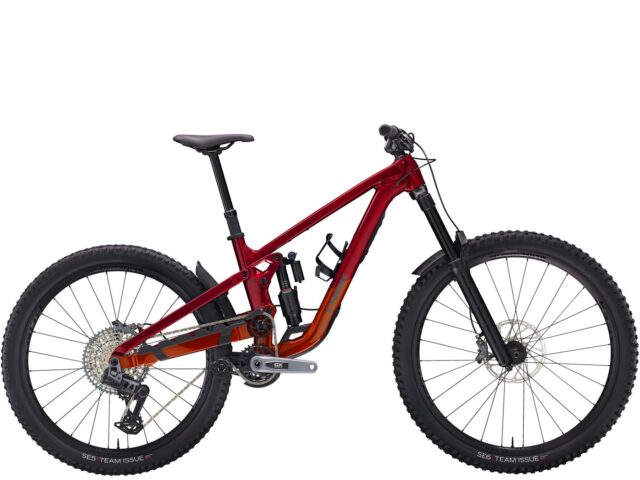
Intro
The Slash has been a longstanding part of Trek’s lineup — dating back to the days of 26’’ wheels — as their long-travel Trail model and eventually their Enduro race bike once that category emerged.
The fifth-generation Slash debuted a little over three years ago now, so it isn’t a big surprise that a new version has now surfaced. However, some of the new design details suggest it’s a more substantial update than simply “half a degree slacker here, a few millimeters longer there.”
The prior-generation Slash was arguably a touch conservative in some aspects of its design and geometry even back when it launched, but you’d be hard-pressed to say the same about the new sixth-generation bike — it’s gotten a big overhaul in just about every facet, and there’s a lot of interesting stuff going on here.
The Slash is now a 170mm-travel bike with a high-pivot layout — clear indications that it’s meant to be a big, gravity-oriented bike. But Trek makes it clear that they mean for the Slash to pedal well and climb efficiently, and say it’s intended to be confidence-inspiring for all sorts of riders on rugged descents, not a super game-on bike for only the hardest chargers out there. But what has Trek done to make that happen? Let’s check out the new Slash.
[And for a bunch more on the new Slash, including its design goals and how Trek went about achieving them, check out Ep.186 of our Bikes & Big Ideas Podcast with the lead engineer on the project, Matt Yerke.]
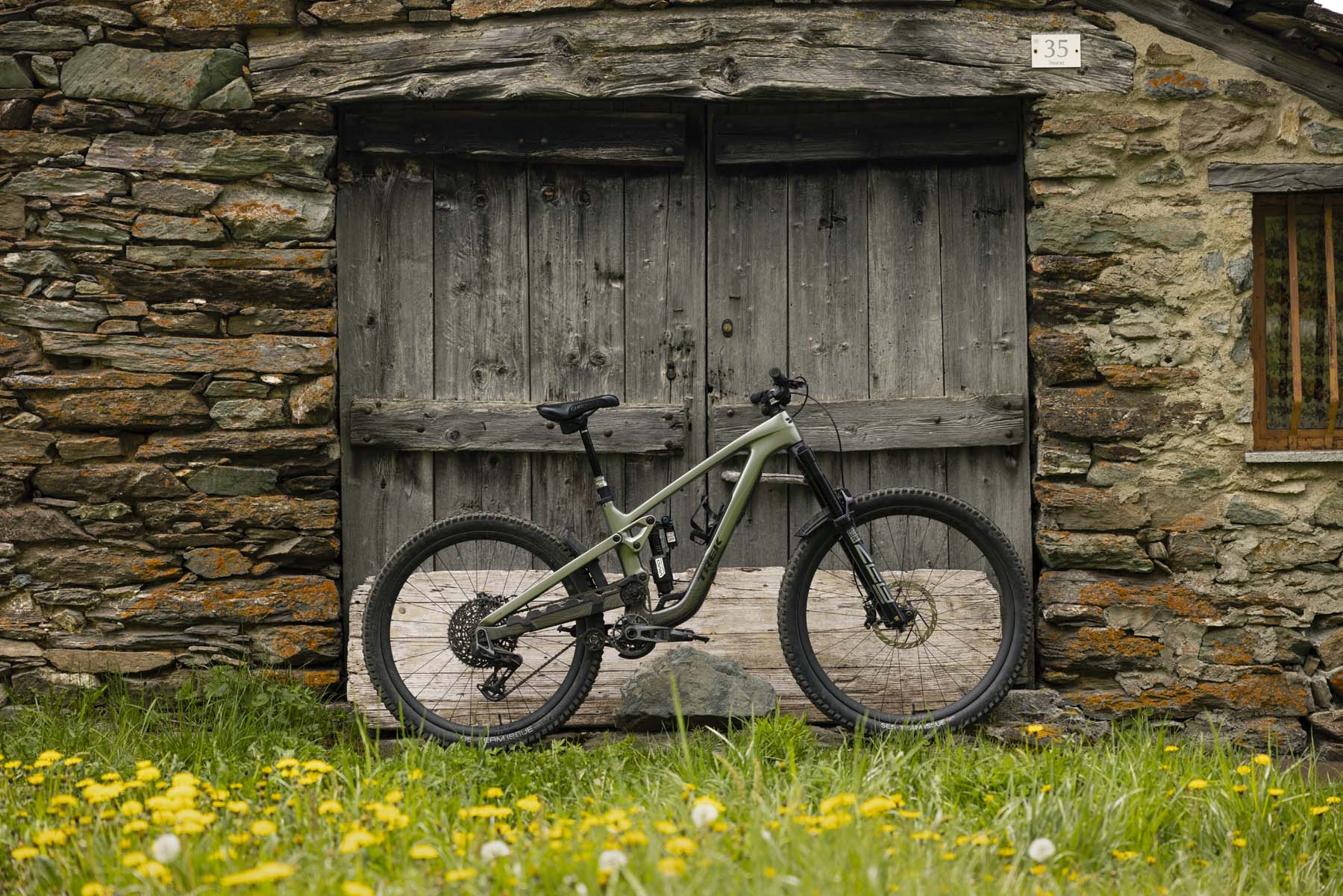
The Frame
Like the fifth-generation Slash, the sixth-gen one is offered in your choice of an aluminum or carbon fiber frame, in sizes ranging from Small through XL with an ML snuck in the middle. It uses Trek’s longstanding ABP suspension layout — essentially a linkage-driven single pivot with a pivot between the chainstay and seatstay that’s located concentric to the dropout, to give a floating brake mount akin to a Horst link bike.
The big visual change is that the suspension layout has been reconfigured to feature a much higher main pivot, necessitating the use of an idler pulley to reign in the interaction between the rear suspension and chain forces, both in terms of anti-squat and pedal kickback. That idler pulley is on the larger side for high-pivot bikes (19 teeth) and is mounted to the chainstay substantially offset from the main pivot. This is in contrast to Trek’s Session DH bike, which mounts its idler concentric to the main pivot; that said, some of Trek’s athletes have been spotted riding what looks to be a prototype chainstay on the Session that moves the idler to a more Slash-like spot below and behind the main pivot.
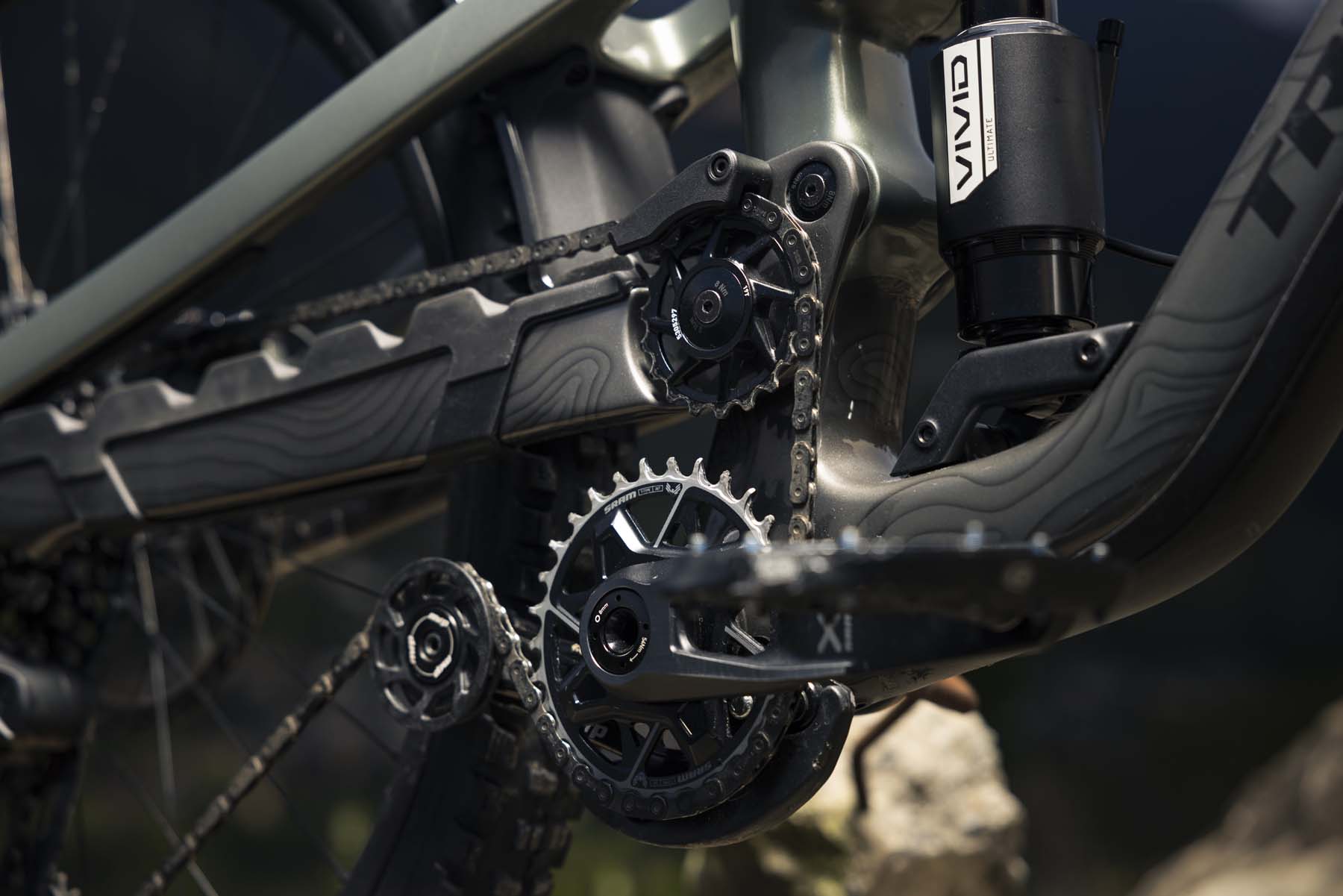
Trek co-developed a lower chain guide specifically for high-pivot bikes, in collaboration with MRP, in order to increase chain wrap around the chainring, improve chain retention, and mitigate derailleur clutch movement (and in doing so, improve small-bump sensitivity from the suspension). That guide actually came out a while ago as the “MXg” and is designed specifically for high-pivot bikes such as the Slash. It includes an integrated bash guard and features a larger-than-average 14-tooth roller to reduce how much the chain has to flex, thereby keeping drivetrain drag to a minimum. It bolts to the lower two mounts of a set of ISCG-05 tabs (the Slash includes all three, though it’s not compatible with conventional upper chain guides due to the idler pulley); an integrated upper guide over the idler is included. The Slash is designed around a 55 mm chainline crank (as featured on SRAM’s new Transmission groupsets) and uses a threaded bottom bracket shell. Despite the extra pair of pulleys, the Slash takes a standard 126-link chain in all sizes apart from the XL (which needs 128 links, due to its longer chainstays — more on those below).
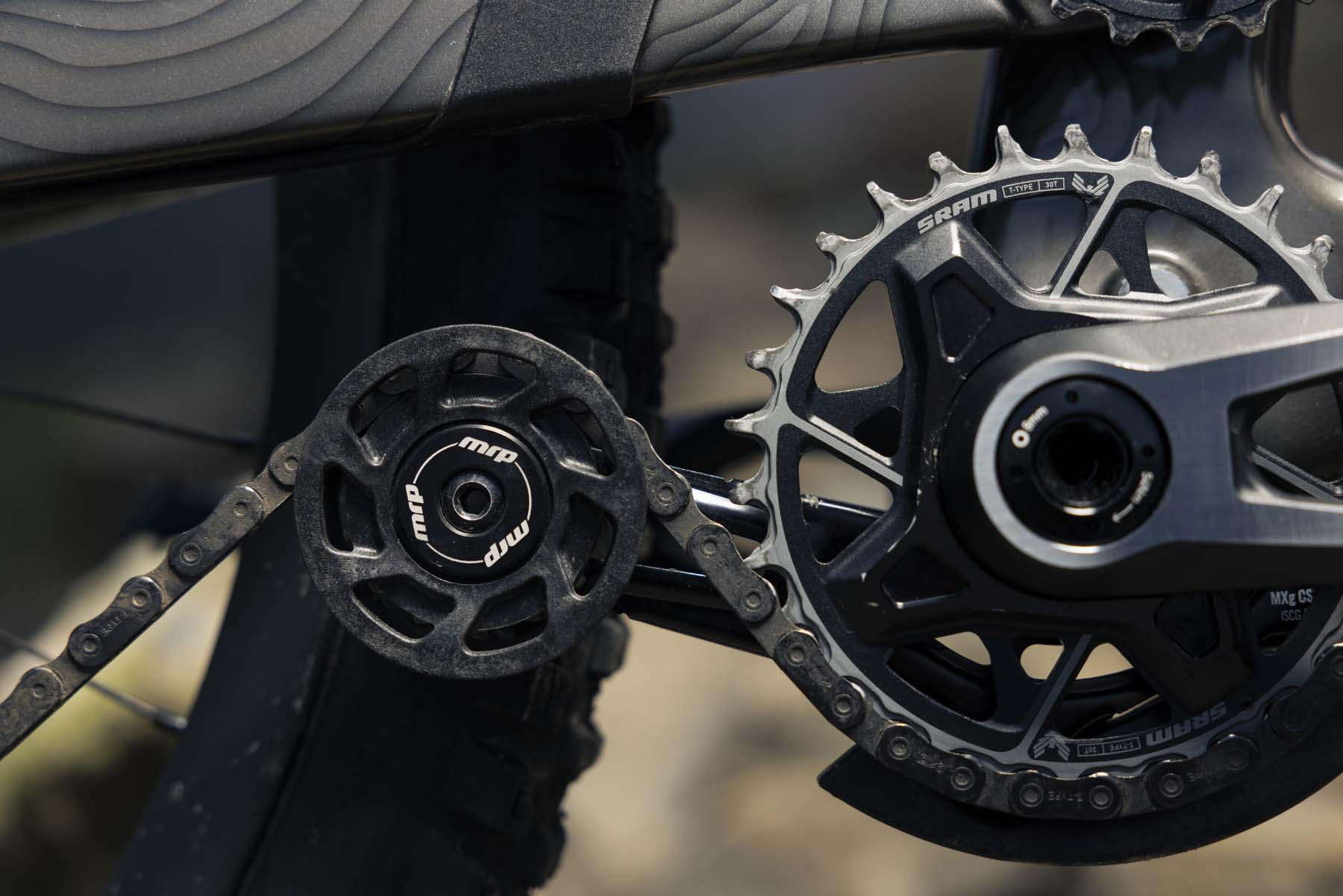
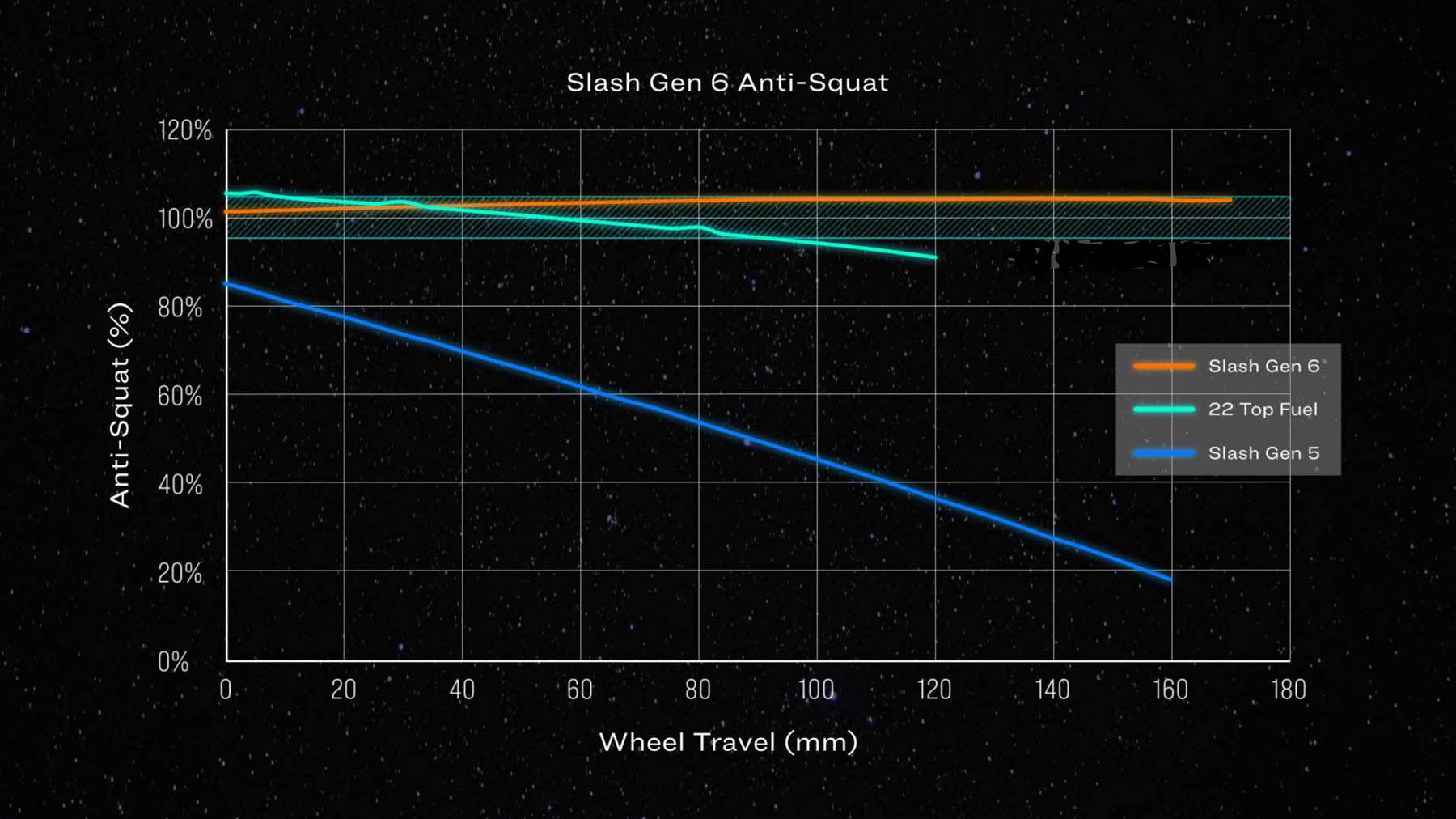
[It’s not labeled in this graph, but Trek says that the published numbers are in a 30/21 gear ratio, with the center of gravity sitting 800 mm above the bottom bracket.]
A flip chip in the sixth-gen Slash’s lower shock mount toggles between two different leverage curve settings, producing either ~20% or ~25% of progression in generally straight lines. A 230 x 65 mm shock produces 170 mm of rear wheel travel and the funky through-shaft shock used on the prior-generation Slash is no more, replaced by a standard RockShox Vivid on most of the complete builds (more on those below). Air shocks are spec’d throughout, but Trek says coils work just fine, too.
Speaking of the lower shock mount, it’s a bolt-on part that can be swapped to toggle between a 27.5’’ and 29’’ rear wheel on the size Medium through XL frames, paired with a 29’’ front wheel. The Small frame gets 27.5’’ wheels at both ends to keep the stack height in check for shorter folks. Interestingly, all the builds and sizes (Small excepted) come in the mixed-wheel configuration, only, with the 29’’ shock mounts sold separately for folks who want to make that conversion.
To round out the frame adjustability, Trek also offers offset angle-adjusting headset cups to toggle between three different headtube angle settings, as previously seen on the Fuel EX and Fuel EXe Al. Bikes ship with the neutral cups installed; the offset ones are available separately. The upper cup is a drop-in installation, but the lower one is a press-in affair.
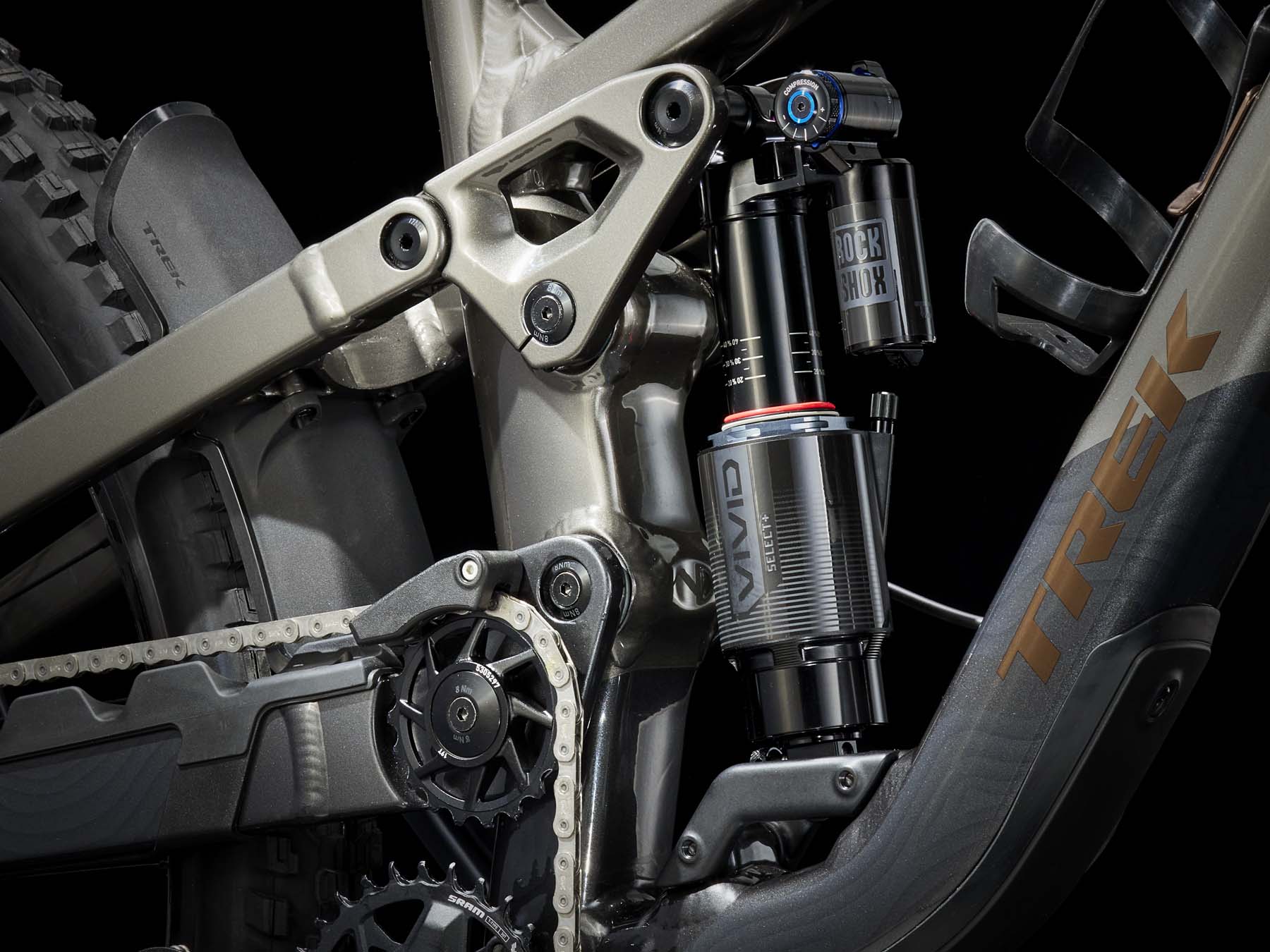
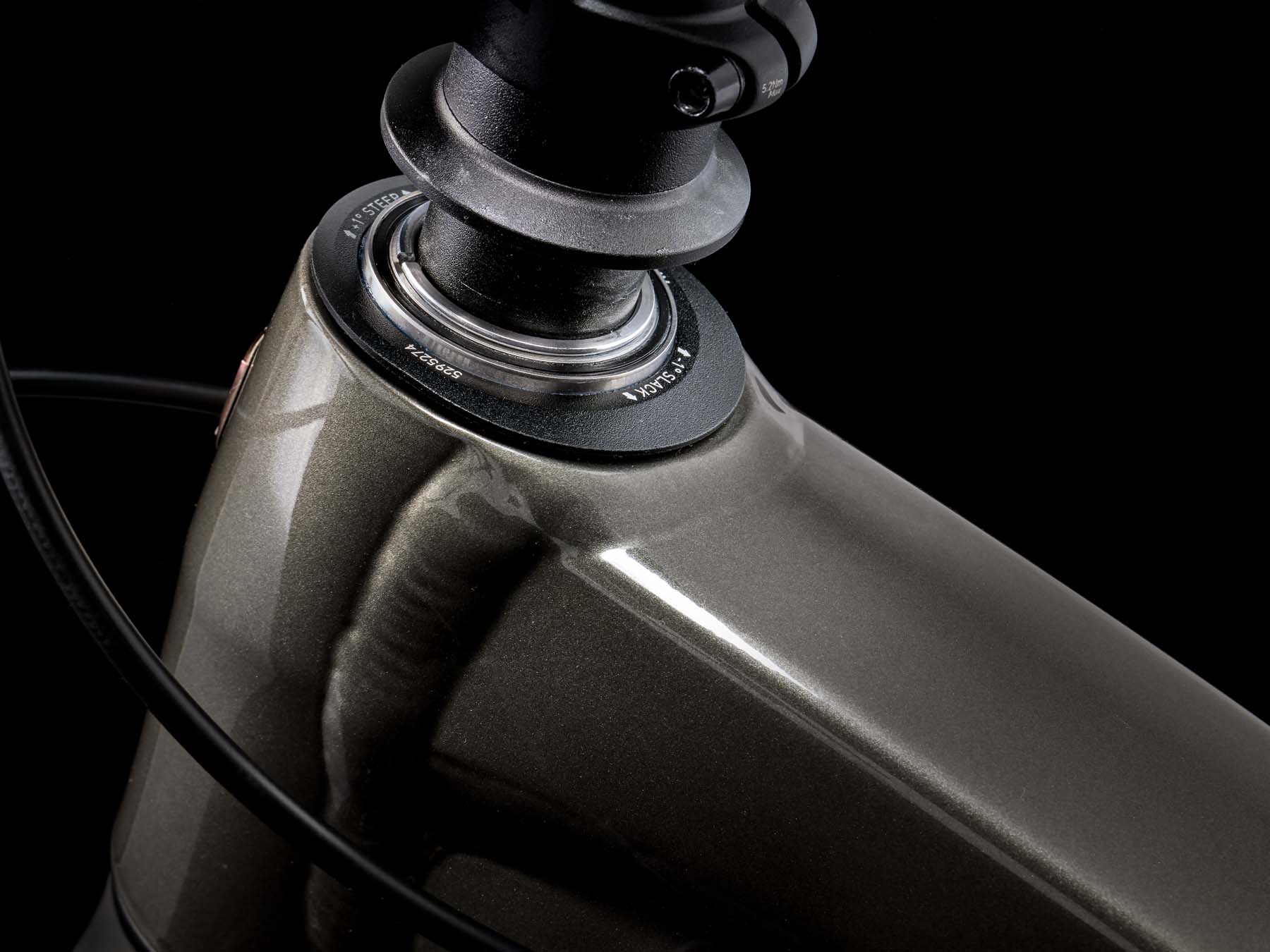
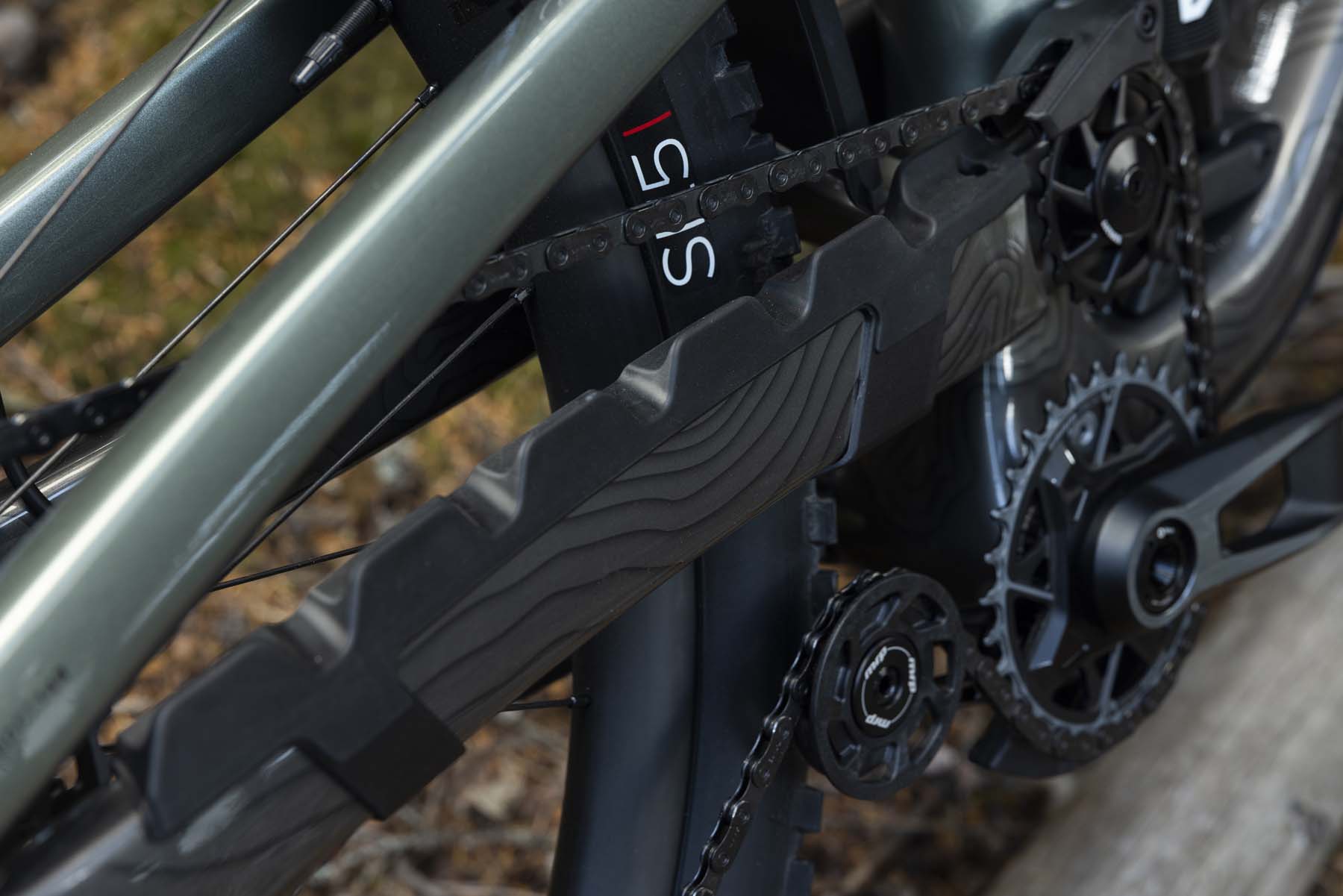

Trek was one of the first companies to offer in-frame storage on mountain bikes, and the new Slash continues the trend with a hatch under the water bottle mount on all frame sizes, in both the aluminum and carbon fiber frames. Cable routing is fully internal, with ports for the rear brake on both sides of the head tube, for folks who run their rear brake on the left side. The Slash features ample rubber guards on the chainstay, seatstay, and downtube, with the downtube guards bolting on for easy replacement should they get damaged. Trek says they’ve also applied a layer of an impact-resistant film underneath the paint on the carbon frames to further protect the frame from damage. A bolt-on rear fender is included as well, though Trek says it’s only compatible with a 27.5’’ rear wheel — there’s not enough clearance with a 29’’ one.
Trek specs the Slash with a 170mm-travel fork, but says that a single-crown fork up to 190 mm travel can be used if you want to go that route. Dual-crown forks, on the other hand, aren’t currently approved, though Trek says that they simply haven’t tested them enough to say for sure either way, so it’s possible they’ll be condoned at some point in the future. Trek has also done away with the Knock Block steering-limiting headset on the new Slash, and single-crown forks easily clear the downtube.
Fit & Geometry
Trek offers the Slash in five sizes, Small, Medium, ML, Large, and XL, with the reach ranging from 430 mm to 508 mm in roughly 20 mm increments. The headtube angle is 63.3° for the Medium frames on up (the Small steepens very fractionally to 63.5°). The effective seat tube angle is around 77° (varies slightly by size), with a still-pretty-steep 74° actual angle for the whole size range. There’s no kink in the seat tube on the new Slash, so dropper post insertion has been greatly improved — Trek says you can bottom a 200 mm post to the collar on a Medium frame. The chainstay lengths now vary by size, with the Small starting at 429 mm and the XL topping out at 439 mm; the Medium comes in at 429 mm, and the ML and Large share 434 mm stays.
All of those numbers are in the stock geometry configuration (i.e., neutral headset cup, mixed wheel sizes on Medium and larger sizes, dual-27.5’’ wheels on the Small). Going to a full 29’’ configuration on the sizes that support it steepens the headtube and seat tube by 0.2°, adds almost 6 mm to the chainstay length, and increases the reach by a couple of millimeters. Installing the offset headset cups either steepens the headtube angle by 0.8° or slackens it by 0.7° with fractional changes to the other geometry numbers.
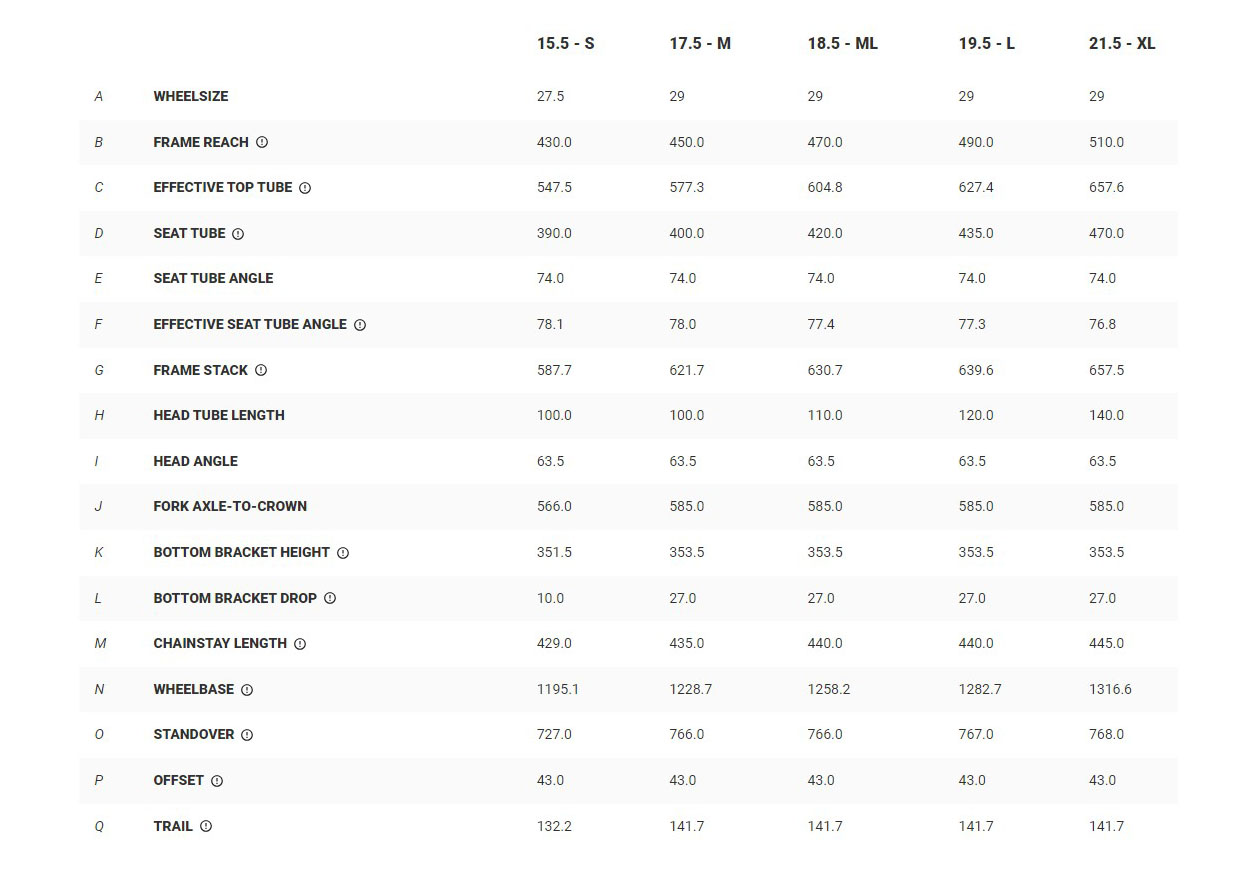
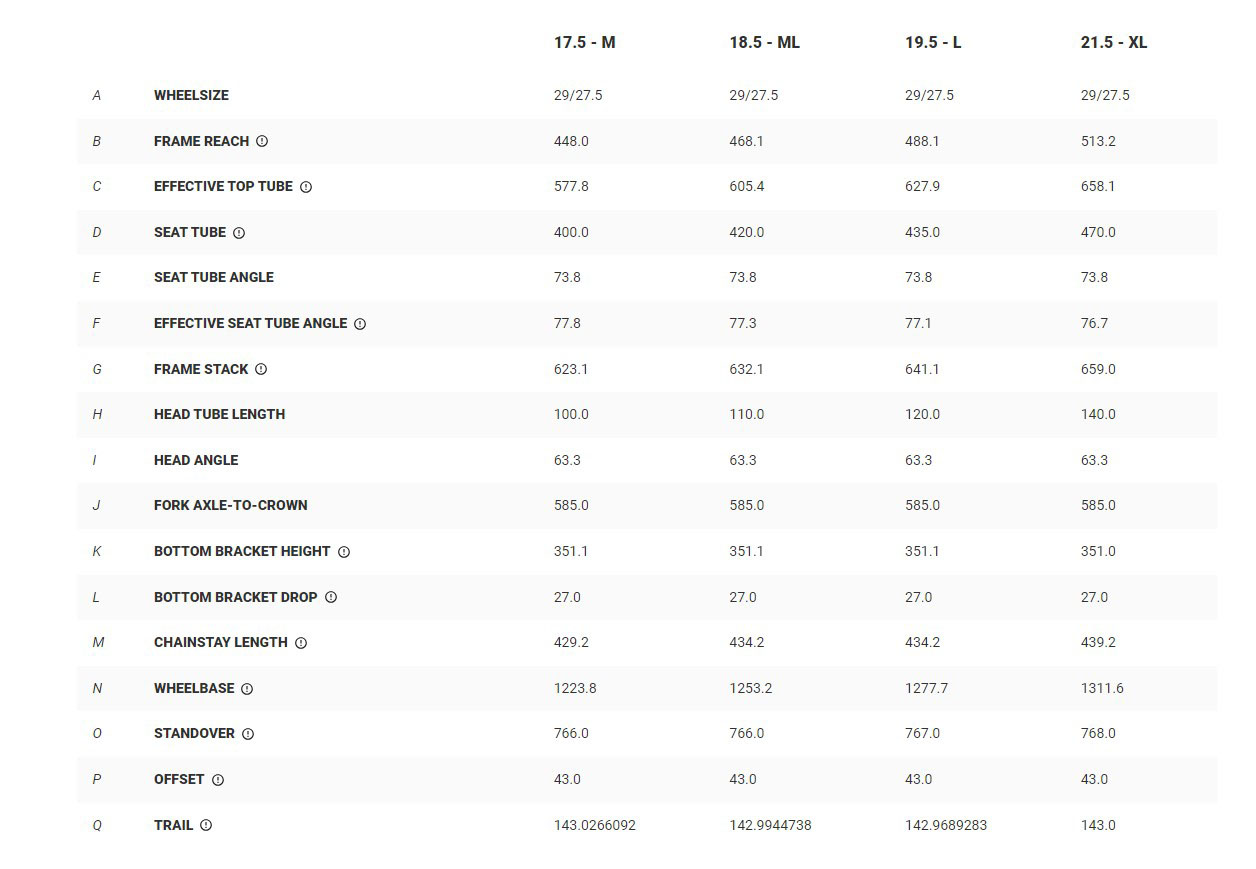
[There’s a typo in Trek’s listed geometry charts, above — the reach on the XL frame in the mullet configuration should be 508.1 mm. And for the full range of charts, including with the offset headset options, check out Trek’s website.]
Those are really nice-looking numbers for a modern Enduro bike. If anything stands out as being a little bit unusual, it’s the fairly short chainstay lengths in the 27.5’’ rear-wheel settings. That said, it’s worth bearing in mind that the high-pivot layout and notably rearward axle path that it produces means that the Slash’s stays are substantially longer at sag, and continue to grow as it cycles deeper into the travel. That’s also why the chainstay length changes so much between the 27.5’’ and 29’’ rear-wheel configurations, and it’ll be interesting to see just how much the different rear-wheel options impact the ride of the Slash. We’ve got a set of the optional 29’’ rear wheel shock mounts for our test bike and will be finding out.
The Builds
Trek offers the Slash in seven complete builds, with pricing ranging from $4,400 to $11,500. There’s a mix of SRAM and Shimano drivetrains in here, but apart from the entry-level Slash 8, all builds get some variant of a RockShox Vivid shock and ZEB fork (with the exact version varying by build tier). As per usual for Trek, builds with a whole number indicate aluminum frames, and “9.X” denotes a carbon one.
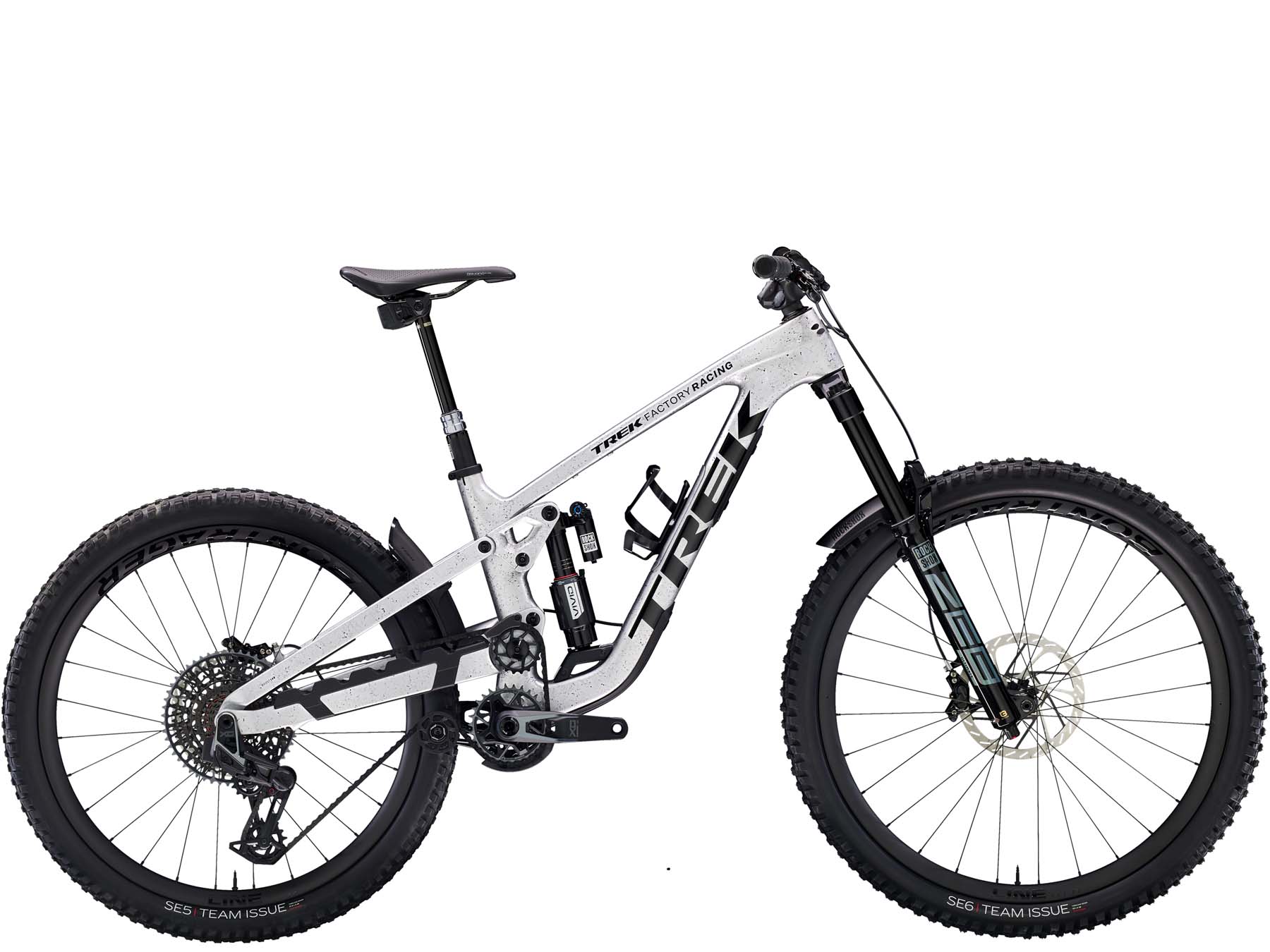
- Drivetrain: Shimano XT w/ Deore crank and SLX chain
- Brakes: Shimano Deore 4-piston
- Fork: Fox 36 Rhythm
- Shock: Fox Float X Performance
- Wheels: Bontrager Line Comp 30
- Dropper Post: Bontrager Line
- Drivetrain: SRAM GX Transmission
- Brakes: SRAM Code Bronze Stealth
- Fork: RockShox ZEB Select+
- Shock: RockShox Vivid Select+
- Wheels: Bontrager Line Comp 30
- Dropper Post: Bontrager Line
- Drivetrain: Shimano XT
- Brakes: Shimano XT 4-piston
- Fork: RockShox ZEB Select+
- Shock: RockShox Vivid Select+
- Wheels: Bontrager Line Elite 30 Carbon
- Dropper Post: Bontrager Line Elite
- Drivetrain: SRAM GX Transmission
- Brakes: SRAM Code Bronze Stealth
- Fork: RockShox ZEB Select+
- Shock: RockShox Vivid Select+
- Wheels: Bontrager Line Elite 30 Carbon
- Dropper Post: Bontrager Line Elite
- Drivetrain: SRAM X0 Transmission
- Brakes: SRAM Code Silver Stealth
- Fork: RockShox ZEB Ultimate
- Shock: RockShox Vivid Ultimate
- Wheels: Bontrager Line Pro 30 Carbon
- Dropper Post: RockShox Reverb AXS
- Drivetrain: Shimano XTR w/ e*thirteen LG1 Carbon crank
- Brakes: Shimano XTR 4-piston
- Fork: RockShox ZEB Ultimate
- Shock: RockShox Vivid Ultimate
- Wheels: Bontrager Line Pro 30 Carbon
- Dropper Post: Bontrager Line Elite
- Drivetrain: SRAM XX Transmission
- Brakes: SRAM Code Ultimate Stealth
- Fork: RockShox ZEB Ultimate
- Shock: RockShox Vivid Ultimate
- Wheels: Bontrager Line Pro 30 Carbon
- Dropper Post: RockShox Reverb AXS
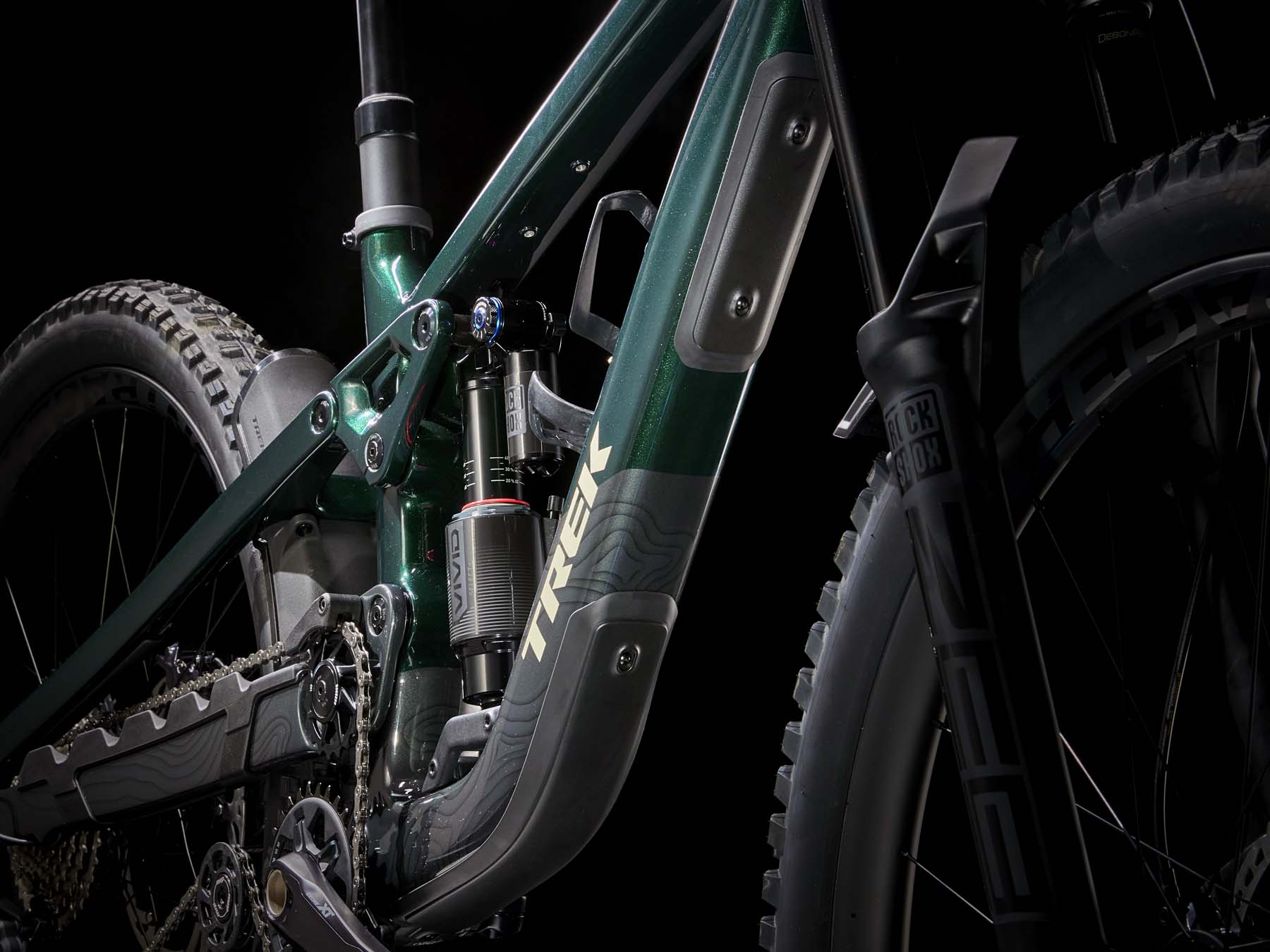
Some Questions / Things We’re Curious About
(1) The new Slash clearly looks to be a true, modern Enduro bike, with geometry and suspension numbers that should make it quite stable and composed at speed. But how versatile is the Slash, and how well does it pedal? Is it an ultra-planted sled of bike (a-la the Norco Range) or is it more well-rounded than that?
(2) How does the Slash stack up against many of the other high-pivot Enduro bikes that have been flooding the market of late, including the Norco Range, Forbidden Dreadnought, Nicolai Nucleon 16, Cannondale Jekyll, Kavenz VHP 16, Contra MC, and more?
Bottom Line (For Now)
Trek’s first high-pivot non-DH bike has been a long time in the making — check out Ep. 186 of Bikes & Big Ideas for a lot more on that, including how Trek considered making the Fuel EX a high-pivot. But it’s finally here, and the new Slash looks to be a compelling take on the genre. We’ve already been spending a lot of time on the Slash and will be logging a lot more miles on it in the months to come — stay tuned for our full review.
Flash Review
Blister Members can read our Flash Review of the Trek Slash for our initial on-trail impressions. Become a Blister Member now to check out this and all of our Flash Reviews, plus get exclusive deals and discounts on gear, and personalized gear recommendations from us.
FULL REVIEW
On paper, the new Trek Slash looks like one of the more emphatically descending-oriented Enduro bikes out there, with 170 mm of travel at both ends and a high-pivot layout derived from their Session DH bike.
We’ve been spending a lot of the summer and fall on the new Slash, and it is indeed very stable, composed, and confidence-inspiring when going very fast on steep, rough trails. But is it just a big bruiser of a bike, or is it more versatile than its numbers might suggest? And how does it stack up against a bunch of the other Enduro bikes out there? The answers are pretty interesting.
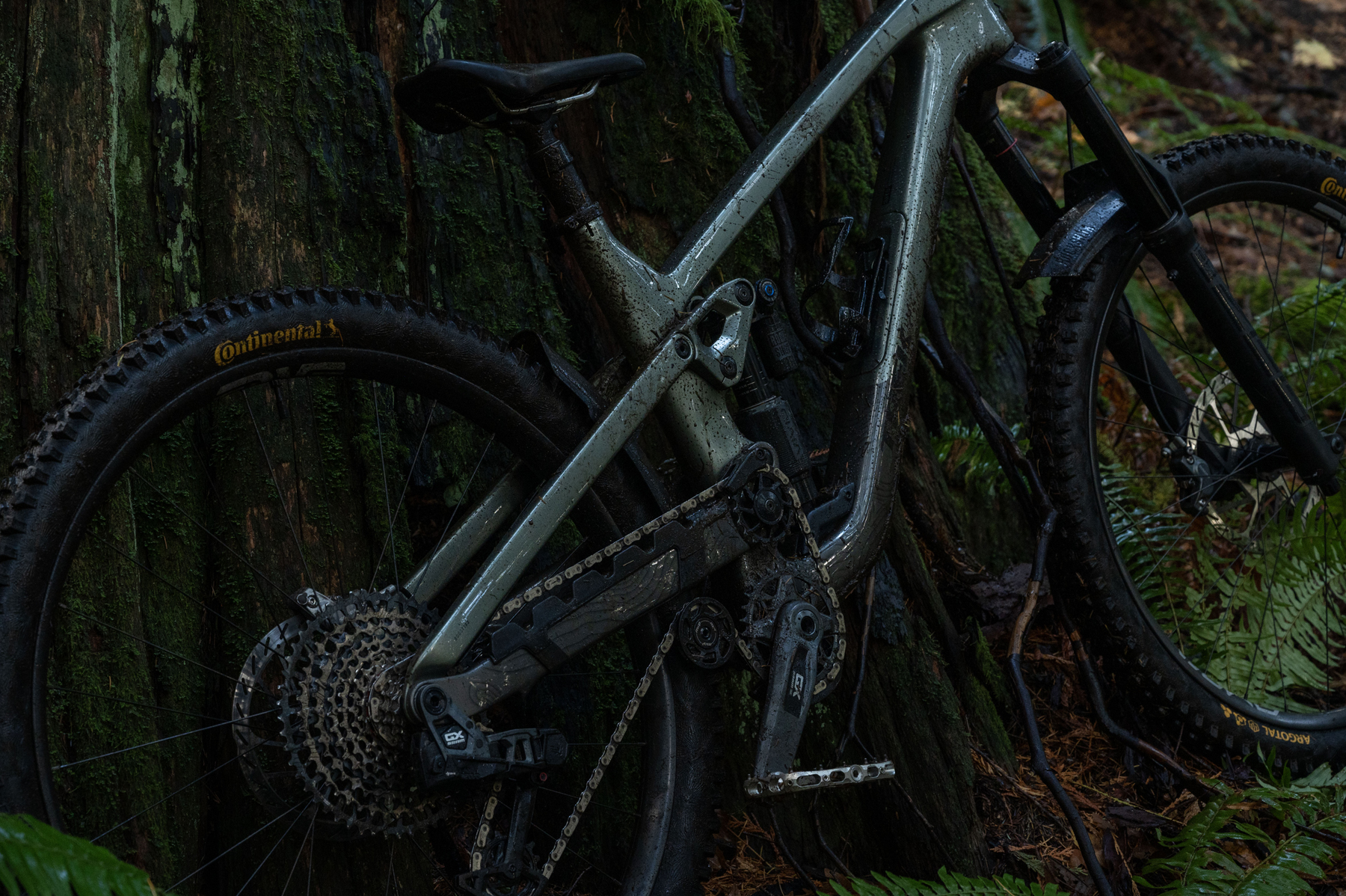
Fit & Sizing
Trek’s recommended sizing for the Slash puts me (6’ / 183 cm) squarely in the middle of the sizing band for the Large frame and outside of the overlapping regions for the M/L and XL sizes. That feels pretty on the money — I had an easy time getting comfortable on the Large Slash and wasn’t ever tempted to deviate from that size. If I were to make any changes to the Slash’s fit I might be tempted to bump up the stack height a little bit. Fortunately, the fork’s steerer tube came cut long enough to allow a hefty stack of spacers, and I wound up swapping out the stock bar for ride-quality reasons anyway (more on that in a minute); a 30 mm rise one suited me nicely.
The Slash’s seat tube is fairly steep (about 77° effective / 74° actual) and the pedaling position feels moderately compact relative to the roomy ~490 mm reach — pretty typical for a modern Enduro bike, but not to the point of feeling awkward on flatter climbs or anything like that.
I honestly don’t have a ton to say here — the Slash fits and feels pretty normal for a modern Enduro bike, and I mean that as a compliment. I had an easy time getting comfortable on it, without anything quirky or surprising going on. And given its relatively small 20 mm steps in reach between sizes, most folks should be able to find a size that works for them.
Climbing
The Slash is a long-travel high-pivot bike, and even with its carbon fiber frame, carbon wheels, and not-super-heavy tires, our size Large Slash 9.8 GX review bike weighs in at 36.6 lb / 16.6 kg without pedals. Given that, I didn’t have the highest expectations for the Slash’s climbing performance when I first threw a leg over it, but it easily cleared the low bar I’d set in my head — the Slash pedals quite well for what it is. As is the case with pretty much every other ~170mm-travel Enduro bike out there, the Slash isn’t particularly interested in climbing quickly, relative to most shorter-travel “Trail” bikes, but if you’re okay with taking things a little easier and spinning (rather than sprinting) your way to the top, the Slash is impressively efficient.
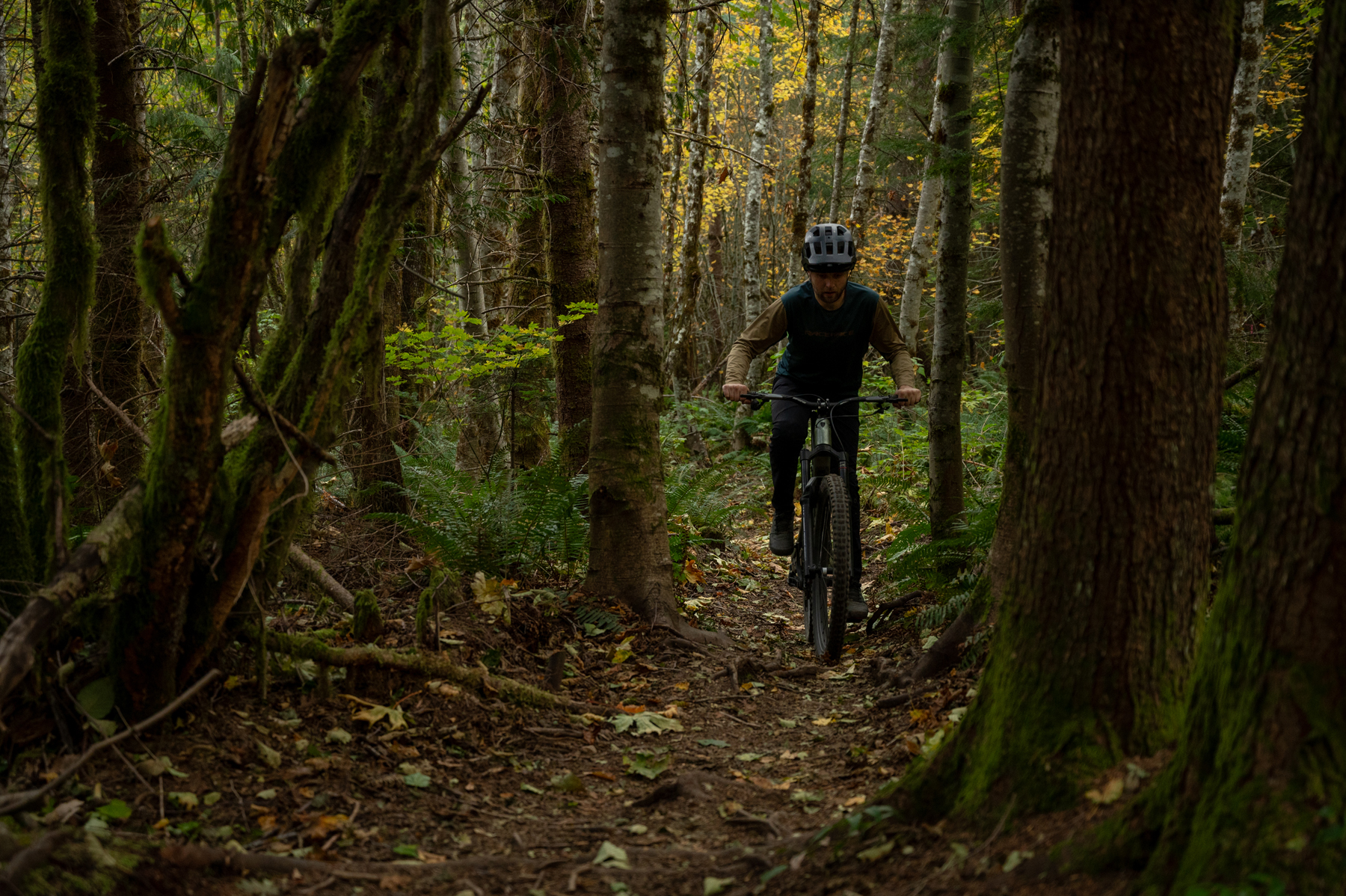
Even with the shock’s climb switch open, there’s not a ton of suspension movement under power, so long as you keep your pedal stroke reasonably smooth. The quite-firm climb switch on the RockShox Vivid adds a very solid platform if you want it. I found myself mostly not bothering with the climb switch very often — the Slash genuinely pedals quite well without it, and I found the loss of traction and comfort to rarely be worth the modest increase in efficiency. That said, I like the combination of a bike that doesn’t need a climb switch and a shock with a notably firm climb setting for the times you really want to eke out every bit of efficiency. I’m a big fan of how the Slash pedals.
As per usual for high-pivot bikes, the Slash does feel like its drivetrain efficiency falls off more quickly as the chain gets dirty and poorly lubed, relative to most bikes with a more conventional drivetrain layout. But provided that the chain isn’t too horrendously gritty and/or dry, the added drag from the extra couple of pulleys on the Slash feels modest. Straight out of the box, there was a bit of noticeable extra noise from the main idler pulley under pedaling, but that quieted down after a ride or two as things wore in, and the overall amount of drag from the Slash’s drivetrain feels very manageable.
The Slash is also a pretty good technical climber, especially from the standpoint of combining solid pedaling efficiency with very good rear-wheel traction under power. As is generally the case with long, low, slack bikes, the Slash can feel like a lot of bike to maneuver through rough, tight, ledge-y sorts of climbs, but it doesn’t feel unduly tough to manage in those circumstances — it just is a long, slack bike, and the tradeoffs there are typical of bikes with geometry numbers like that of the Slash. When things get really tight and awkward, a shorter-travel, more nimble bike is going to be easier to manage, but for the sorts of climbs where the main challenge is simply maintaining rear-wheel traction and keeping momentum, the Slash does quite well.
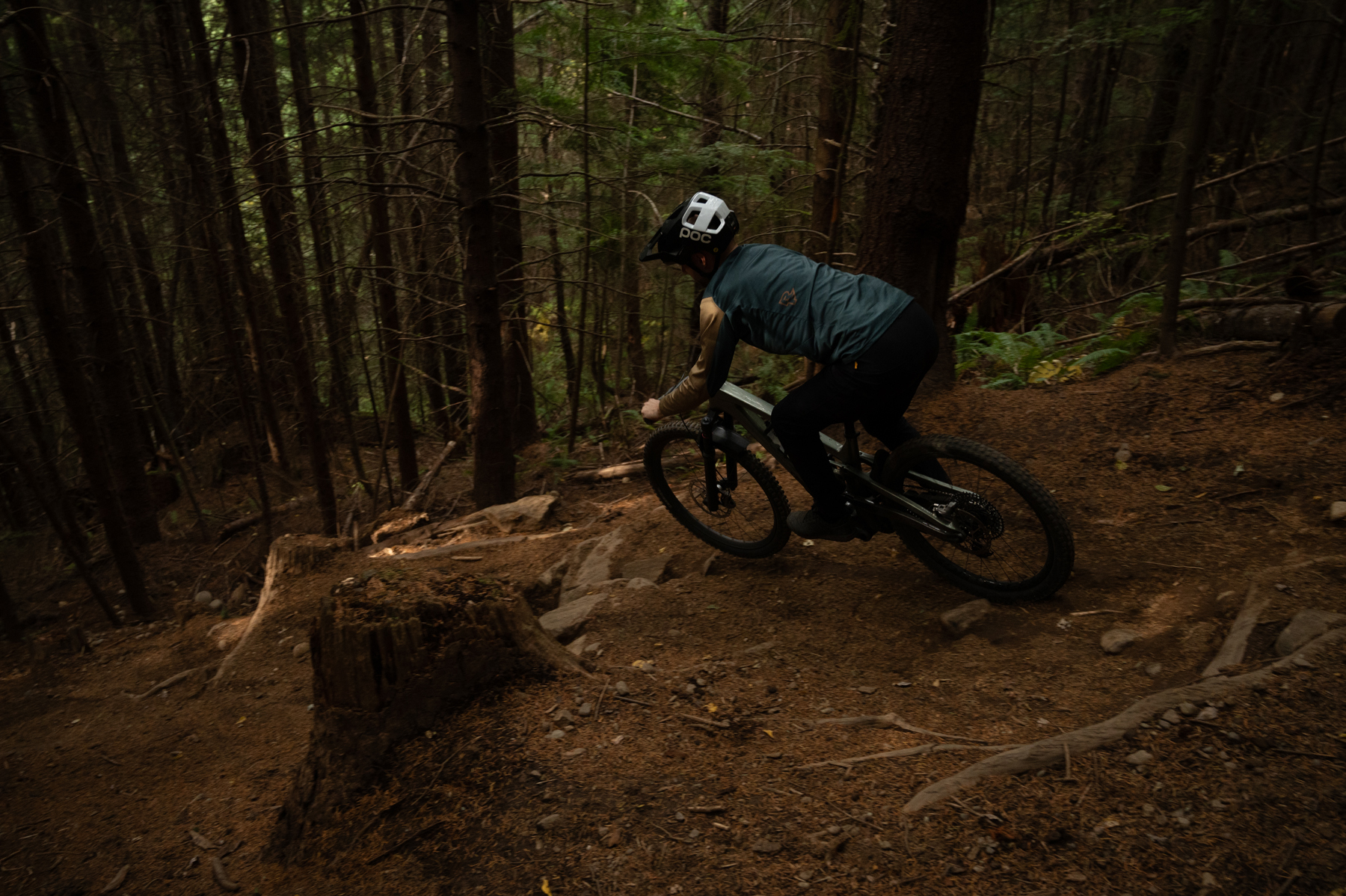
Especially in the stock mixed-wheel-size configuration, I did find myself wanting a bigger chainring than the stock 30-tooth one — the 30 x 52 low gear combination, paired with a 27.5’’ rear wheel, felt too low to be useful in most circumstances, and on some of the steeper climbs around here, I found myself wanting a gear between first and second. It would, of course, be an easy fix to swap in a larger chainring if you end up feeling similarly, though I (at least partially) solved the issue by swapping in a 29’’ rear wheel for much of my time on the Slash — a setup that I wound up personally preferring mostly for handling reasons, as I’ll describe in more detail below.
While the Slash does a commendable job of getting to the top under human power, it’s a bike that’s meant for the trip back down. So:
Descending
The Slash is, unsurprisingly, quite composed and confidence-inspiring when it comes to riding steep, technical trails at speed. It’s stable and planted without being so glued to the ground that it’s all that difficult to “get light” on and skip over holes and rougher bits. It also carries speed quite well when given enough pitch and space to let the bike run a bit. None of that should come as a surprise for a 170mm-travel high-pivot bike. However, the Slash does an especially good job of doing all that smash-y big-bike stuff while also being impressively intuitive and comparatively manageable in slower, tighter spots and/or when you’re taking things easier.
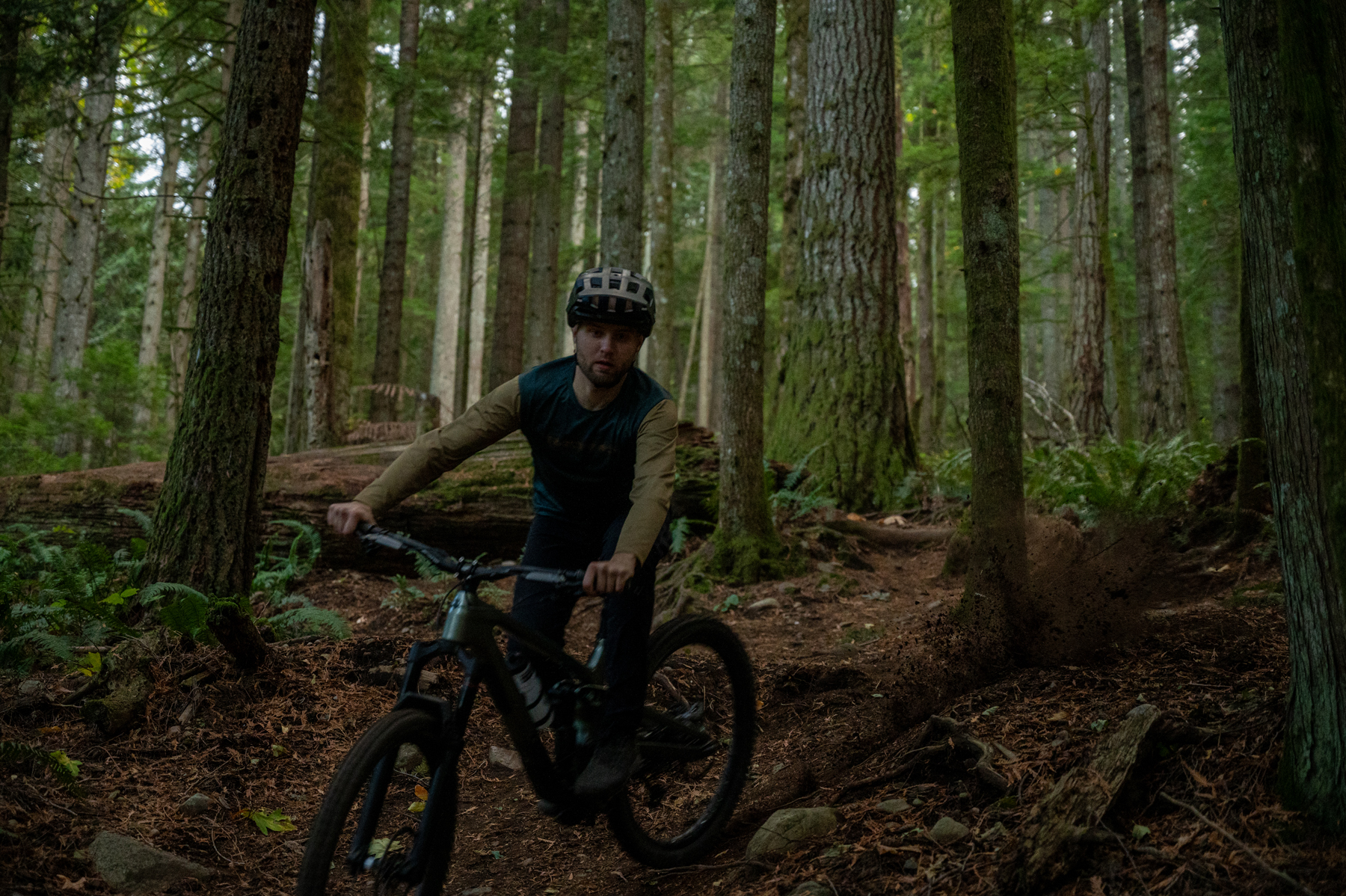
Of course, that’s all relative — the Slash is a long, slack, bike, and it’s not going to trick you into thinking you’re on a much more nimble, shorter-travel one when things get tight and awkward. But the Slash is very consistent and predictable, and that goes a long way toward making it easy to manage in a wide range of situations. The Slash’s braking performance is quite neutral, and it doesn’t have the same kinds of handling quirks that some bikes with ultra-rearward axle paths can display as the rear center (and therefore the balance point on the bike) changes wildly though the travel (e.g., the Forbidden Dreadnought). The Slash is generally just very, very intuitive in both its handling and suspension performance.
Not needing to translate and react to what the bike is doing simply makes the Slash easy to get on and go, whether you’re flat-out charging or just want to have an easier time while riding steep, difficult trails. As with pretty much every bike in this sort of travel range, I wouldn’t recommend the Slash if you’re not going to be taking it down steep, technical descents on the regular. But for what it is, the Slash is pretty versatile, both in terms of the sorts of riders who I can see getting along with it, and in that feels more manageable than a lot of other similarly composed, stable bikes when you’re not going flat out.
The Slash also does a relatively good job of still being able to maintain speed by pumping — not a strong suit of high-pivot bikes in general — and otherwise facilitating a more dynamic, active riding style for being as stable and composed as it is when you just want to let the bike plow. That “relatively” is important — we’re talking about a big, very stable bike after all, and if you’re after a truly lively, energetic ride, you’d be better off with something lighter, shorter-travel, and more compact. But the Slash is impressively well-rounded for what it is.
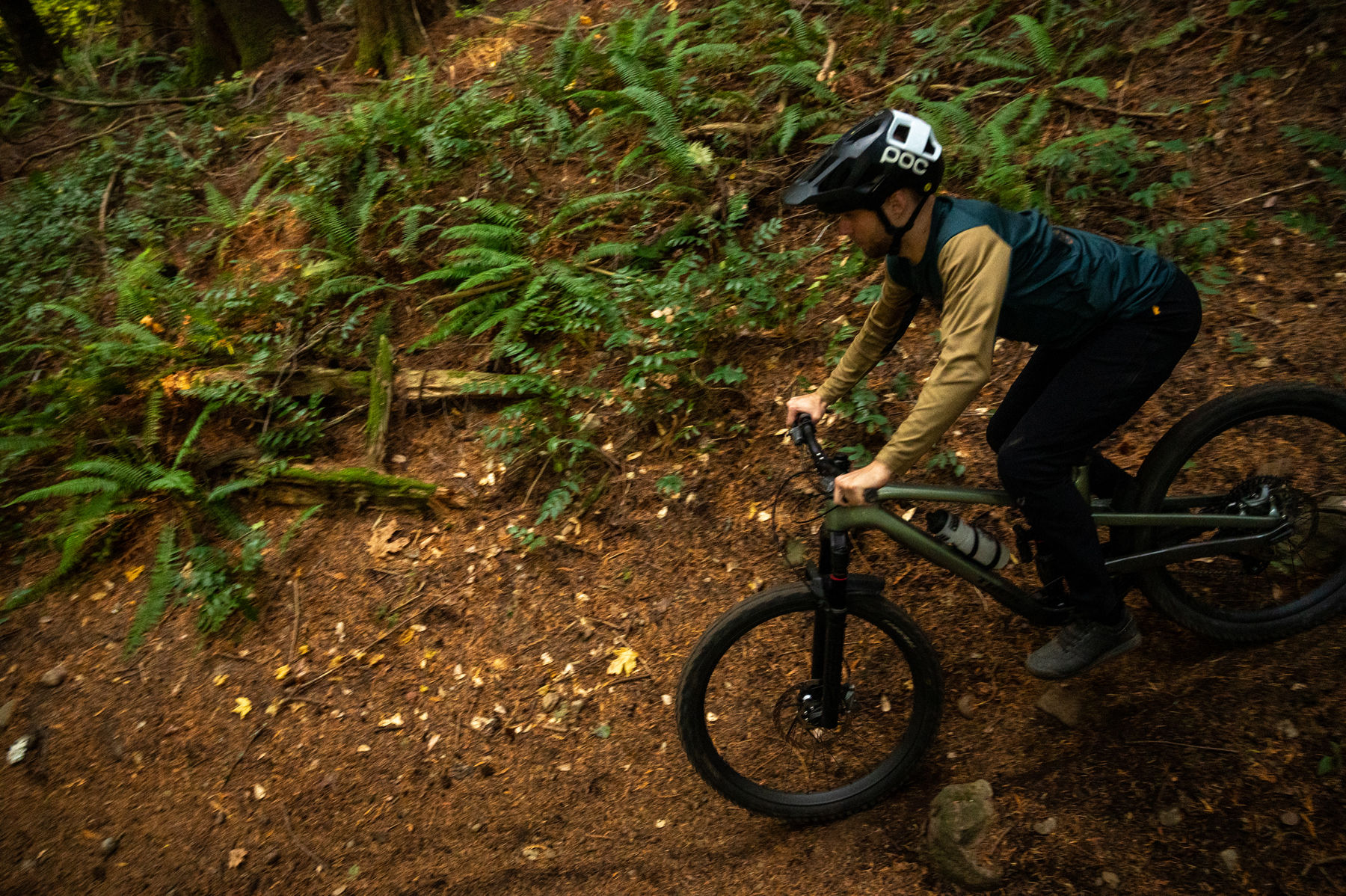
The fact that the Slash doesn’t feel exceptionally glued to the ground and eager to iron out every little bump probably helps in that regard. When you start going faster and hitting things harder, it is quite composed and confidence-inspiring in how it deals with bigger impacts and compressions, but isn’t exceptionally plush and cushy feeling on smaller chatter. It does a good job of maintaining traction on off-camber roots and the like, but does still transmit a bit of feedback about what the wheels are doing. Some bikes (e.g., the Norco Range) iron out every bit of trail chatter more completely than the Slash. However, those bikes also tend to feel “dead,” less rewarding and energetic when loading them up to pop off something, and/or lack support through the middle part of the travel. The Slash hits a really nice middle ground there.
On that note, I found myself preferring the more progressive of the Slash’s two linkage settings; it offered improved bottom-out control and support deeper in the travel, especially when carrying speed into a really rough section of trail, where the lower progression setting felt slightly more prone to settling deeper in the travel and feeling slightly less balanced in how the bike used its front and rear travel. It’s not a stark difference by any stretch, and the lower progression setting feels plenty useable, especially for folks who want to make the Slash a little more supportive and lively in the beginning part of its travel. It’s easy to toggle back and forth, especially if you also loosen the two bolts that fasten the lower shock mount plates a turn to make aligning the shock hardware easier, and is worth experimenting with if you’re curious.
Wheel Sizes
Toggling between the Slash’s stock mullet wheel configuration and the optional full-29er setup doesn’t make for a massive change in the Slash’s character, either, but offers a relatively subtle twist on the same overall recipe in roughly the ways you’d expect. The smaller 27.5’’ rear wheel option makes the Slash a little quicker handling and correspondingly not quite as stable at speed, but I’d say the bigger difference is that it moves the Slash’s preferred balance point forward and biases it more toward being ridden with weight over the front wheel — bear in mind that the mixed-wheel configuration also shortens the chainstays considerably. The mixed-wheel setup also makes the back end quicker and easier to come around if you keep the front end weighted. The more you want to, well, slash and drift turns, the more the mullet configuration is likely to make sense; the 29er setup makes the Slash’s sweet spot feel bigger, especially if you’re riding it more centered and loading up the bike through the pedals in corners.
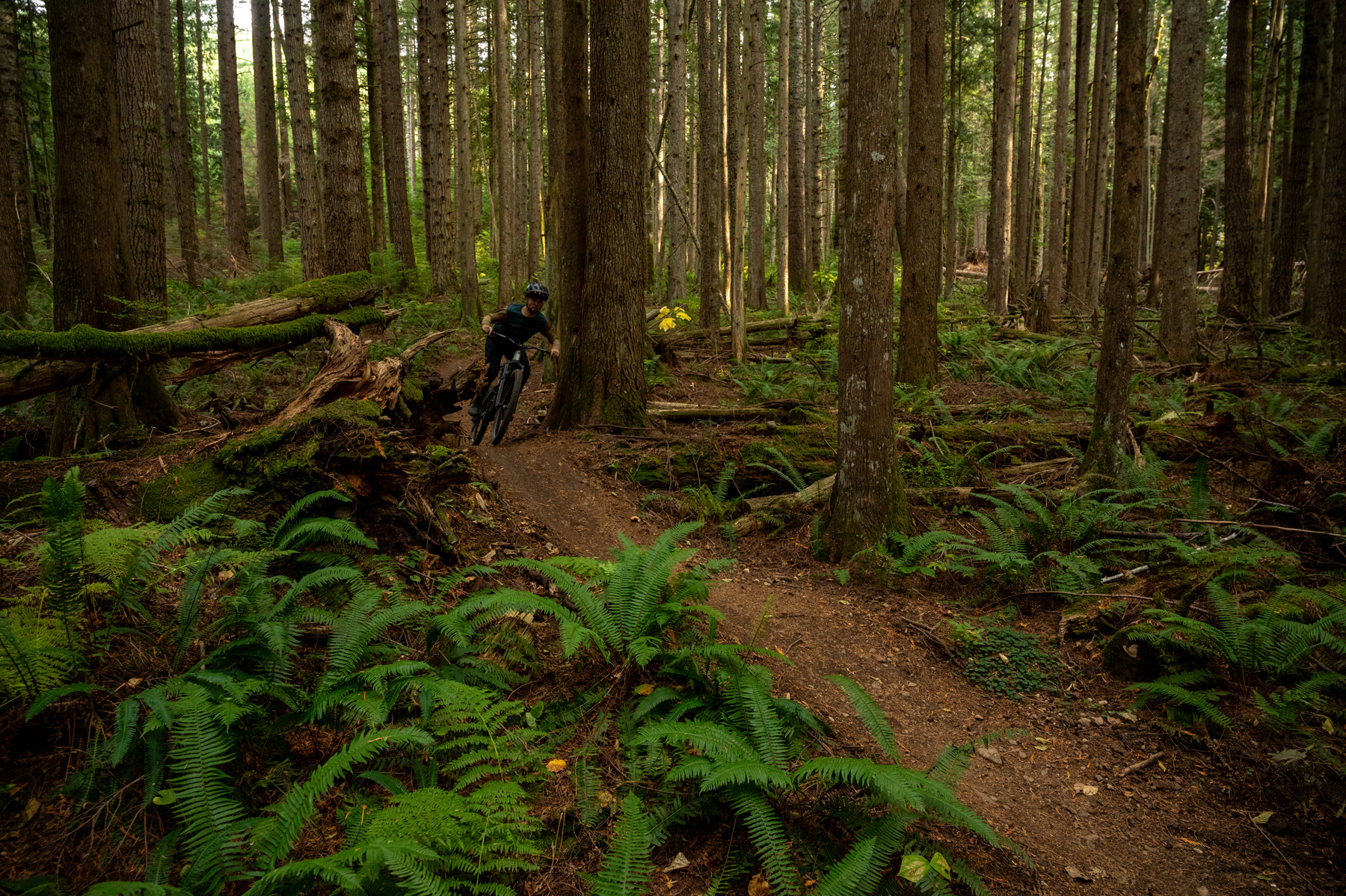
I found myself preferring the matched 29’’ wheels for that reason — they just give me a bigger platform to move around on the bike without upsetting its weight distribution between the wheels. As a result, they made it easier for me to push hard at speed. The mixed-wheel setup was more fun on trails where the Slash was borderline overkill and arguably makes it a little more versatile overall.
Still, the Slash is a big, descending-oriented bike that just happens to be a little more versatile than many other bikes that are similarly composed at speed in rough terrain, rather than a truly versatile all-rounder, so I found myself preferring to lean into what the Slash does best and emphasizing its stability and composure with the dual 29’’ setup. That said, I’m widely on record as not being the biggest fan of mixed-wheel bikes in general — especially those with shorter chainstays, and the Slash’s get substantially shorter in the mixed-wheel configuration. So that’s probably at least as much a confirmation of my general preferences as it is a reflection on the Slash itself.
The Slash’s frame (at least the carbon version; we haven’t been on the aluminum one) also feels very stiff overall, which has both pros and cons relative to some less stiff frames. Perhaps most interesting has been the Contra MC that I’ve been testing alongside the Slash (more on that below, and full review coming soon). The quite-stiff Slash frame feels notably precise and direct in how it responds to rider inputs, and very predictable when it comes to being able to feel how the rear wheel tracks through corners when there’s a lot of lateral load on the bike. The downside is that the Slash transmits more small chatter and feedback than a lot of less stiff frames (the MC being a particularly good example). The Slash’s suspension still provides good overall grip and does a nice job of maintaining traction on chattery, rooty sections, but it simply doesn’t feel quite as smooth or planted as I think it might if the frame was a bit less stiff.
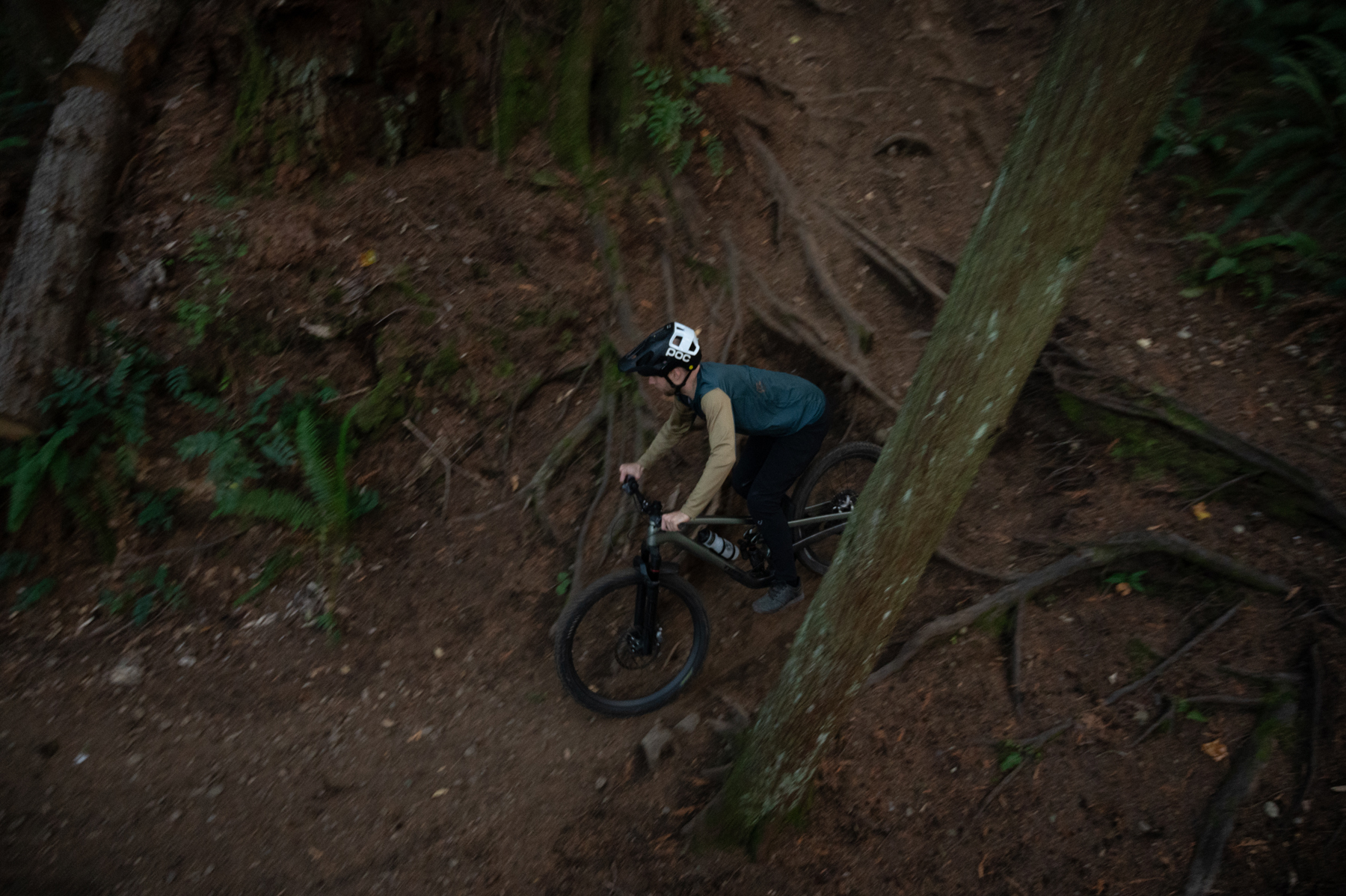
Chain Retention
And now for the elephant in the room. There’s been a lot of chatter across various corners of the internet about the Slash dropping chains left and right, and while I did drop the chain a few times over the course of my testing, it seems to be solvable, and ultimately a matter of chainguide setup. Here’s how it all went during my testing:
The Slash showed up as most review bikes do: mostly assembled, with the front wheel and handlebars removed in order to box up the whole thing. I started with the chainguide installed as it came from Trek; I dropped the chain off the underside of the chainring fairly quickly. The chainguide pulley looked like it was positioned pretty low, so I rotated it upward a bit, increasing the amount of chain wrap around the chainring, and everything was solid — no more dropped chains.
But then Trek sent a note saying they’d sent some early bikes out with the chainguide installed incorrectly, and things got a little more complicated. MRP, who make the lower guide, put together a document explaining how to set it up, with two main points: (1) there should be 7 mm of spacers between the ISCG tabs and the guide itself, to align the pulley with the chainring and (2) there should be a specified gap between the head of the chainguide mounting bolts and the end of the slot for them on the guide, setting the height for the pulley. Our bike showed up with 6 mm of spacers, and even after I’d previously clocked the guide upward, it was still quite a bit lower than MRP suggested, so I set everything up to their spec… and started dropping the chain a lot more regularly — this time off the inside of the pulley on the chainguide.
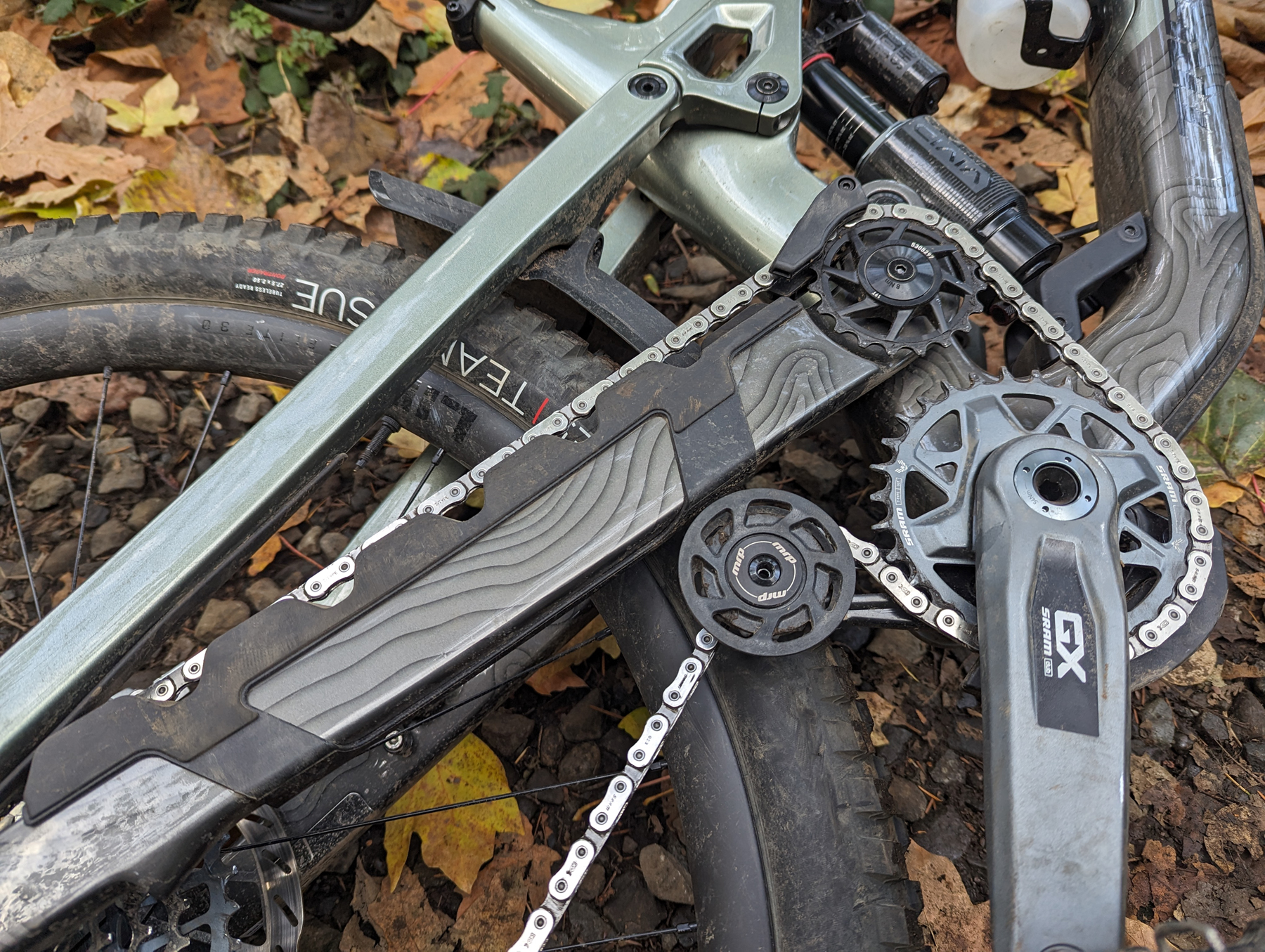
I followed up with Trek, and got word back that they’d been hasty in sending out the last set of recommendations — the 7 mm spacing was correct, but the pulley should be positioned lower than the MRP document called out, with 32 mm of spacing between the underside of the chainstay protector and the top of the pulley. And once I moved the guide back down to that setting, the chain stayed put — no more trouble again.
While that might seem counterintuitive, it makes some sense. Rotating the guide higher does increase the amount of chain wrap around the chainring (and therefore improves retention there) but also decreases the amount of chain growth along the lower run of the chain as the suspension cycles on the Slash — so that portion of the chain loses tension as the suspension compresses. Lowering the pulley a little bit increases tension on the lower portion of the chain as the suspension cycles, and for me, stopped the chain from coming off the chainguide pulley.
It’d certainly be nice if the chainguide setup wasn’t as sensitive, but there does seem to be a Goldilocks setting that works well. While I didn’t measure super precisely, the middle setting that I ran the guide in for the bulk of my testing was pretty close to the 32 mm spacing that Trek later recommended. Through that period, I had no issues with dropping the chain (even with the sub-optimal 6 mm spacing from the frame), nor did I have dropped chains after going to Trek’s stated 32 mm chainstay-to-roller gap and correcting the frame-to-guide spacing to 7 mm.
The Build
The build on our Slash 9.8 GX T-Type review bike is generally quite solid, though it’s not an especially great value for the money, at $8,000. The SRAM GX Transmission works well, and I’m a fan of the RockShox ZEB / Vivid suspension package; I didn’t miss the Buttercups (ZEB) or high-speed compression adjuster (Vivid) on the Select+ versions here too badly, as compared to their top-tier Ultimate counterparts. I was also glad to get the 200mm-drop Bontrager Line Elite dropper as compared to the 170mm-max RockShox Reverb AXS that comes on the 9.9 X0 build (I’m still very, very surprised that RockShox has yet to release a longer version). I didn’t get along with the shape of the Bontrager RSL one-piece bar / stem combo that comes on the higher-end 9.9 builds when I tested it on the Fuel EX earlier this year, and I also found the Bontrager Line Pro one that came on our Slash to be very, very stiff. I swapped it out for something more compliant and comfortable (a Spank Spike Vibrocore).
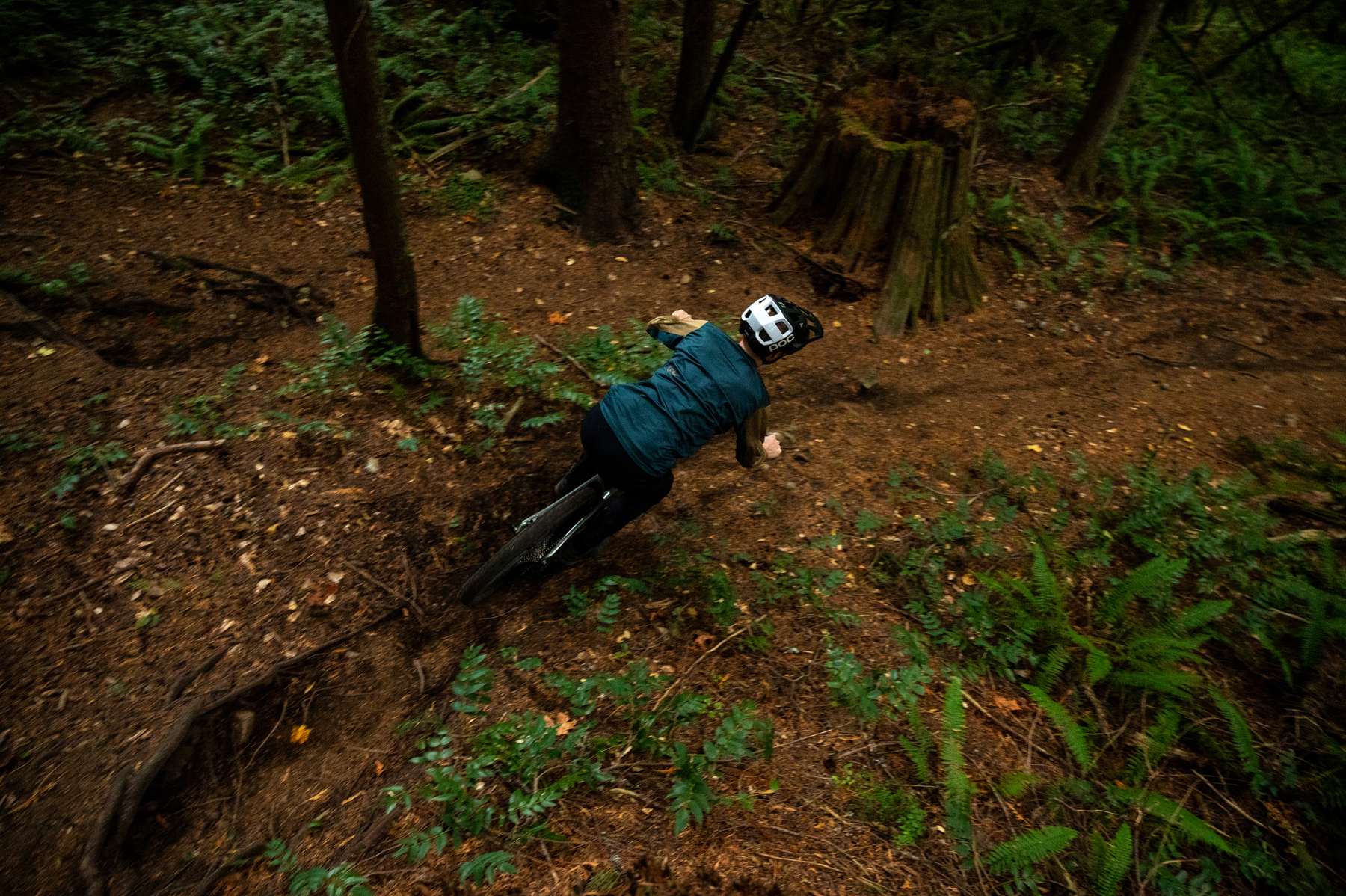
I also wasn’t a huge fan of the stock Bontrager SE6 front / SE5 rear tire combo — they work alright in drier conditions, but their relatively firm rubber doesn’t inspire much confidence on wet roots and rocks, and I also didn’t take long to put a couple of small holes in the casings. I swapped those out for beefier, grippier rubber (Continental Kryptotal DHs) for most of the test period, which felt better suited to the Slash’s capabilities.
While I was swapping wheels around, I also took the opportunity to put on a 220 mm front brake rotor. The SRAM Code Bronze Stealth brakes are a substantial improvement over the Code Rs that they effectively replace as the entry-level Code offering (I think mostly because they feature the Swinglink lever cam that the Code Rs lacked). But they’re still not the most powerful brakes out there, and the bigger front rotor helped on that front.
I would also love to see Trek offer the option for some full-29’’ builds on the Slash, at least in the larger sizes. Mullets are trendy and I absolutely get their appeal, especially for shorter folks on longer-travel bikes who could use some more tire-to-butt clearance. But as I described earlier, I personally clearly preferred the 29er setup on the Slash and it’d be nice to have the option without having to buy another wheel.
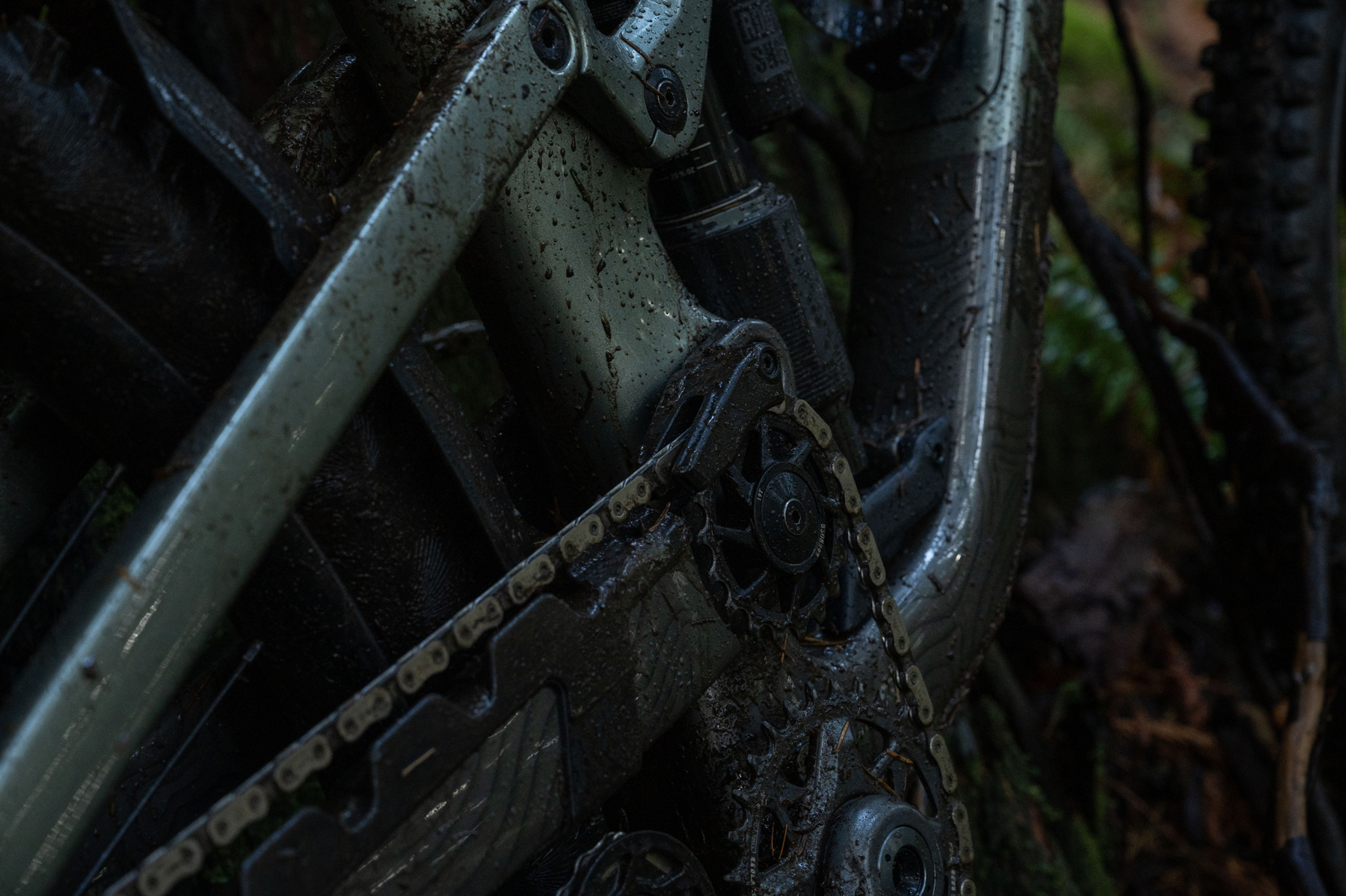
Who’s It For?
The Slash is a big, burly bike and is best suited to folks who are going to spend most of their time seeking out steep, technical descents — and try to ride them at pace. While it’s not the most engaging at lower speeds and on mellower trails, the Slash does pedal notably efficiently for what it is. It also does a very respectable job of not feeling completely out of its element if you’re taking things easier, and is generally very predictable and intuitive in its handling. The Slash would be a great Enduro race bike for folks whose preferences trend toward wanting a bike on the more stable, planted end of the spectrum, or those who just want a very confidence-inspiring bike for tackling big descents that still pedals to the top quite effectively, too.
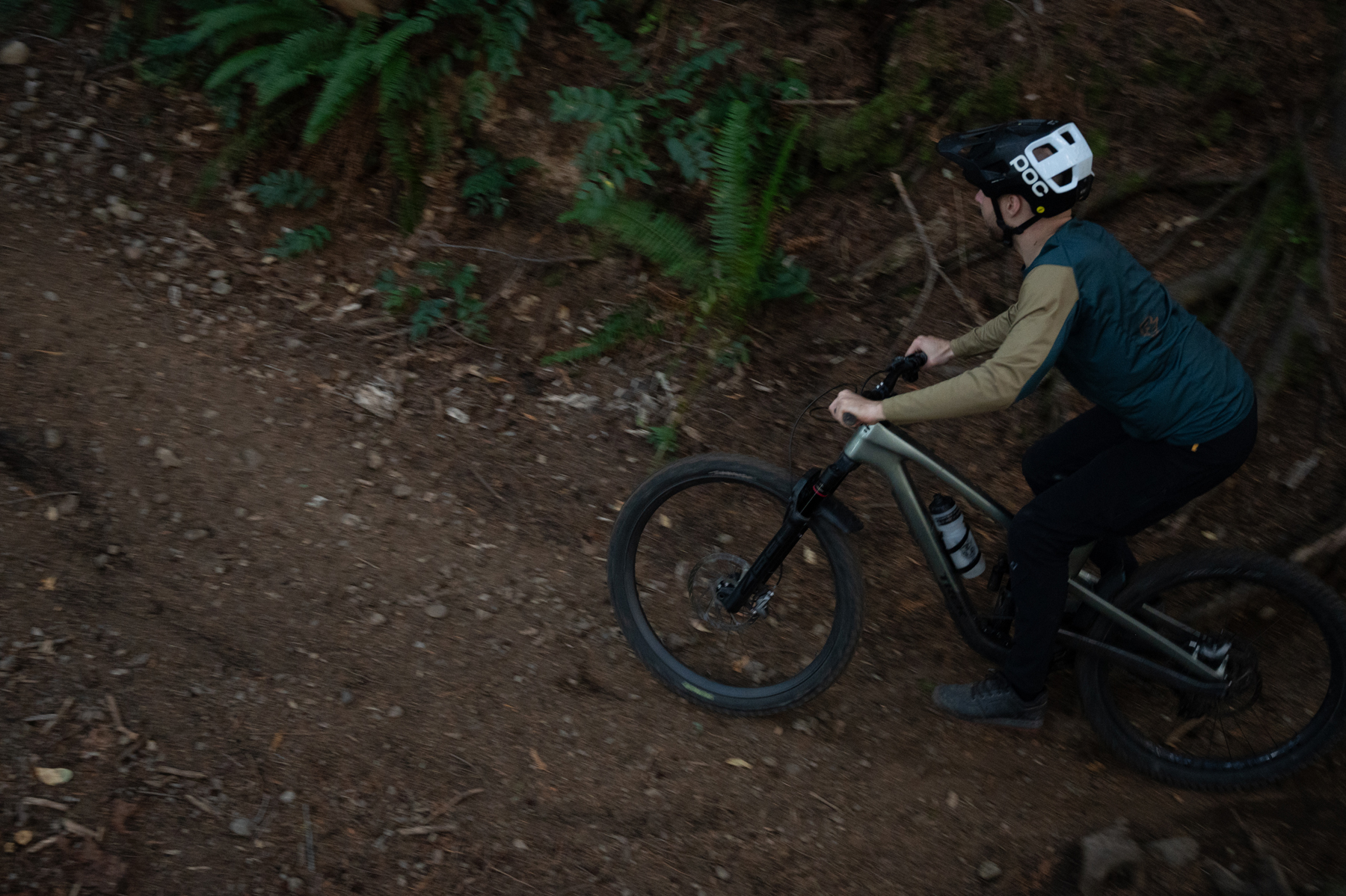
Bottom Line
The latest Trek Slash is undeniably a lot of bike — we’re talking about a 170mm-travel high-pivot platform, after all. It’s quite stable at speed, very composed and confidence-inspiring on steep, rough trails, and is less engaging on flatter, more mellow trails than most shorter-travel options out there.
But the Slash also pedals quite efficiently and does a surprisingly good job of feeling manageable in a relatively wide range of scenarios, beyond just wanting to charge on really burly descents. It would be nice to see a stock 29er option for the Slash, but as is it’s a great option for folks who want an especially stable, composed Enduro race bike, or a bike that’s particularly confidence-inspiring on very steep, rough descents while still pedaling relatively efficiently, and being a little more lively than most similarly planted and composed options, too.
Deep Dive Comparisons
BLISTER+ members and those who purchase our Digital Access Pass can check out our Deep Dive comparisons linked below. Get our Digital Access Pass to view all our Deep Dives and Flash Reviews, or become a BLISTER+ member today to get access to that and a LOT more, including the best worldwide Outdoor Injury Insurance, exclusive deals and discounts on skis, personalized gear recommendations from us, and much more.
Check out our Deep Dive comparisons of the Trek Slash to see how it compares to the Contra MC, Cannondale Jekyll, Norco Range, Forbidden Dreadnought, Canfield One.2 Super Enduro, Yeti SB160, Pivot Firebird, Santa Cruz Megatower, and Propain Tyee.

Trek makes some great products and I’m sure they have done a ton of testing, but having owned an idler bike (cannondale jekyll), I will never own a 2 idler bike.
Nice and thorough review. I was looking forward to your comparison to the Nomad v6, any quick thoughts?
Pretty different. The Slash actually pedals a little more efficiently but is more stable at speed and less nimble / easy to throw around. And especially with the Slash in the stock mullet configuration they prefer quite different body positioning, with the Nomad favoring a much more centered, upright stance.
At a quick glance the most strikingly similar design to the Slash seems to be the Kavenz VHP 16 which was an interesting bike reviewed earlier this year. As someone interested in the Kavenz because of your exposure I’d love to know how they compare.
Otherwise, another great review!
Good call, though they don’t remind me of each other that much.
The Kavenz is more lively, nimble, and generally playful feeling; the Slash is more stable, planted, and feels more focused on going fast / outright composure at speed. The Slash feels fairly manageable in tight spots and on mellower trails for what it is, but the Kavenz is quite a bit more versatile overall.
What if you could try the Kavenz with the newer longer chainstays? Seems like a lot of straight line stability and nimbleness comes from the chainstays.
I’d want to try it before I say anything definitive, but the Kavenz with the new adjustable length chainstays (and tweaked sizing — I’d probably go up to an XL on it now, especially with longer chainstays) seems really intriguing.
Exhaustive. Can you pls compare the Slash to HD6?
We’ve been trying to get on an HD6 but haven’t been able to make it happen yet, unfortunately.
Curious to know what your suspension settings were?
Great stuff David!
Any comparisons between the Slash and Altitude? My previous bike was a YT Capra, which I had really grown to love, but I broke it so I have to move on.
I’m quite late to the party here, but I just got on a slash in L (geo is pretty much spot-on to ideal numbers) but I am finding it to be disappointingly “heavy handed”, for lack of a better way to describe it. My local trails are winch and plummet, steep, committed, filled with features (20’+ doubles), and not all that bumpy… they are maybe a bit tight (as in narrow and have lots of well supported turns), but our trail building style lends itself to pretty high speed limits so I like a bike that feels very capable, but also fairly precise. I think the main issue with the slash is that I am not getting along with it’s unpredictable weight balance due to its varying rear-end length (I guess high pivots just aren’t my jam).
I am really interested in picking up a RM Altitude in L (it has what would literally be the geo numbers I would pick for a dream custom made bike), but I’m worried it may feel like just as much as a handfull as the Slash… The sizing will be more on-point and the ‘normal’ rear axle path should be just right, but I’m worried it’s suspension performance will be too ‘deep’ feeling for my penchant for big jumps and active riding style.